
Вы спросите, почему семь цветов - семь дней - семь прогулочных маршрутов - семь термальных купален.
Я не назову, пожалуй, такой второй столицы в Европе, где бы так органично сочетались два различных направления отдыха – экскурсионный и курортный. И если вы решили отдохнуть поздней осенью, то Будапешт – то, что доктор прописал. Если вдруг пойдет дождь или снег – горячие термальные источники вас всегда спасут.
И хотя поездка была в доковидные времена, памятники и интересные места остаются на прежних местах. И даже купальни работают с определенными ограничениями.
Международный терминал не очень большой и разобраться, как выйти к автобусной остановке, достаточно легко. Запаситесь кредитной картой с Pay Pass для оплаты билетов на автобус, и вам не нужно будет менять валюту в аэропорту. Билеты продаются в автоматах, мультиязычное меню (есть на русском языке). Мы добирались автобусом до метро, что бы попасть в центр Будапешта. Возле станции метро находиться большой торговый центр. Там есть обменник (присутствует комиссия) – если крайне нужны форинты, но мы при посещении Венгрии стараемся менять валюту в банках (в ОТП банке всегда хороший курс ).
Поскольку планировалось много передвигаться по городу, я выбрала апартаменты с удобной локацией в районе ж/д вокзала Nyugati.
Историческая справка: В 1846-м ветка, связавшая Пешт и расположенный севернее город Вац, стала первой в Венгрии железной дорогой. Со временем пассажиропоток значительно увеличился, и существовавший небольшой вокзальный павильон уже никак не справлялся с ним. Решено было заменить его более современным зданием. Свой проект предложила французская фирма «Эйфель», прославившаяся на весь мир знаменитой башней в Париже. Новый вокзал был построен в 1877 году по прогрессивной для тех времен технологии – с использованием стального каркаса.
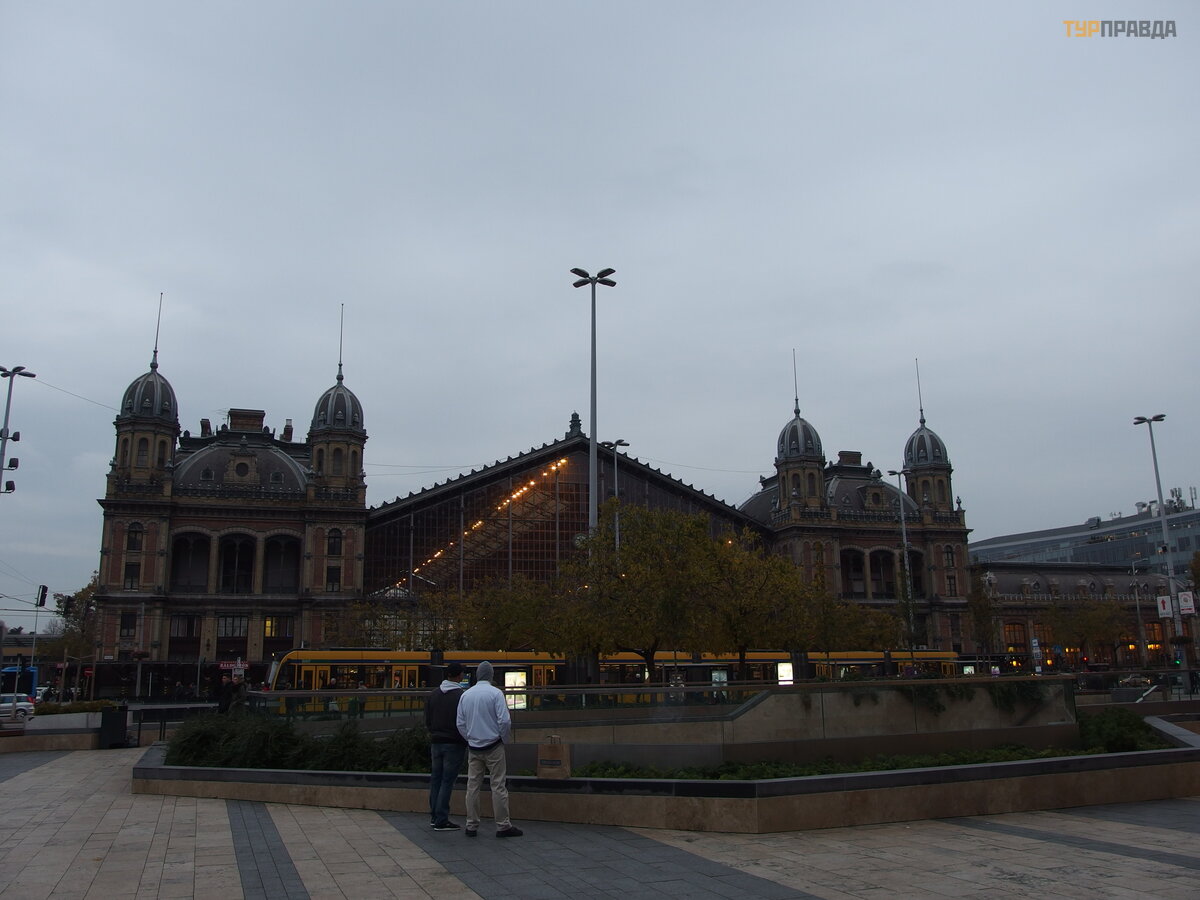
План поездки был продуман с учетом размещения и оптимального передвижения по городу (если приезжать на неделю выгодно купить недельный прездной) Прогулки каждый день было запланировано обязательное посещение разных термальных купален в том районе, где предполагалась экскурсия.
Цвет красный – романтический
В день приезда (2-я половина для), а это была пятница мы доехали до гостиницы Астория и прошли по улице Kossuth Lajos, до моста Эржебет (Erzsebet hid). Нашей целью на эту ночь была самая роскошная турецкая купальня «Рудаш» (Rudas fürd).
Историческая справка: Гостиница "Астория" была построена в 1914 г. События революции 1956 г. принесли этому зданию печальную известность. 25 октября здесь собрались демонстранты, чтобы помешать колонне танков продвигаться к зданию парламента. Начиналось все достаточно мирно, протестанты и советские солдаты разговаривали друг с другом, люди втыкали цветы в дула танков. Но раздался выстрел и был убит советский офицер. В ответ на это с войска открыли огонь по манифестантам, что привело к человеческим жертвам.
Идя по улице Kossuth Lajos стоит обратить внимание на два красивейших здания Будапешта дворцы Клотильды.
Принцесса Мария Аделаида Амалия Клотильда Саксен-Кобург-Готская и Кохари после замужества стала эрцгерцогиней Австрийской, принцессой Венгрии, Чехии и Тосканы. В этих дворцах, кстати, никогда не жила): Два жилых дворца украшают въезд на мост Эржебет. Здания выглядят практически идентично. Они были выстроены в 1902 году для невестки эрцгерцога Иосифа – Клотильды. План зданий создали Флориш Корб и Кальман Гиргел. Дворцы выдержаны в необарокко стиле с элементами рококо. Прежде все помещения в зданиях были жилыми, а сегодня только на верхнем этаже размещаются престижные апартаменты, а нижние уровни занимают магазины, кафе и галерея живописи.
Историческая справка: Мост Эржебет (Erzsebet hid) получил свое название в честь погибшей в 1898 г. Императрицы Австро-Венгрии Элизабет (Сисси).Он является четвертым постоянным мостом через Дунай. В год своего строительства (1903) он считался самым длинным подвесным мостом , и этот рекорд он держал до 1926-го года. Кстати, если приглядется, то известный мост «Золотые Ворота» в Сан-Франциско чем-то на него похож. Во время войны мост также был взорван немцами. Это единственный будапештский мост, который по техническим, экономическим и транспортным соображениям восстановлен не в соответствии с первоначальным проектом ( 1964г. по проекту Пала Шавой).
И в завершении вечера романтическая прогулка по мосту и не менее романтические купания. Просто захватывающий вид на ночной Будапешт окрывается с верхней терасы купальни. Только по пятницам и субботам с 22:00 и до 04:00 совместне романтические купания. И вот почему.
Историческая справка: Горячие источники на берегах Дуная были известны еще со времен короля гуннов Атилы и вождя венгерских племен Арпада. В сохранившихся письменных памятниках периода правления короля Жигмонда (XIV-XV вв.) были отмечены купальни, которые находились, видимо, на месте нынешних купален «Рудаш» и «Рац». В этих документах отмечается, что «купальни эти очень красивы и горячи». В XVI в. во времена короля Матьяша, у подножия горы Геллерт также существовала королевская купальня. Согласно историческим документам, вода источников особенно помогала при лечении кожных заболеваний и атрофии. Долгое время принято было считать, что строительство купальни «Рудаш», точнее, строительство небольшой купальни на месте нынешнего «Рудаша», в 1556 г. начал Мустафа Соколи. Более вероятным кажется, однако, что бывший будайский паша Али в 1556 г. принял решение о небольшой реконструкции купальни. Эту реконструкцию продолжил Мохамед, а затем уже Мустафа Соколи создал роскошную купальню, соответствовавшую восточным вкусам. В описании турецкого путешественника Эвлиа Челеби купальня называется «Купальней с зелеными колоннами» (Jesil direhli ilidzse), так как одна из восьми колонн, поддерживающих купол над бассейном, была зеленого цвета. После 12-колонной купальни Вели-бека это была самая красивая и самая большая турецкая купальня Буды.
После освобождения Буды и ликвидации турецкого ига купальня перешла в собственность Императорской и королевской сокровищницы. В 1696 г. Липот I подарил ее Буде. В этот период она получила название Бюргербад, т.е. Гражданская купальня. Городское руководство Буды сдавало купальню в аренду. Арендаторы проводили те или иные реконструкции здания, состояние которого постоянно ухудшалось. Все насущнее становилась необходимость общей реконструкции и модернизации купальни. 19 апреля 1866 г. городская ассамблея Буды взяла в свои руки управление купальней. Под контролем городских властей постепенно реконструировались отдельные части купальни. Из общего помещения выделили отделение для парной бани, а в 1896 г. открылся и плавательный бассейн. С 1936 г. купальней могли пользоваться только мужчины, а после завершившейся в 2005 г. реконструкции возможность купаться в купальне «Рудаш» получили и женщины. По вторникам купальню могут посещать только женщины, а суббота и воскресенье объявлены общими. А вот понедельники, среды и четверги и пятницы по-прежнему принадлежат только мужчинам :))))
Официальный сайт https://www.rudasfurdo.hu/
Цвет оранжевый – парламентский
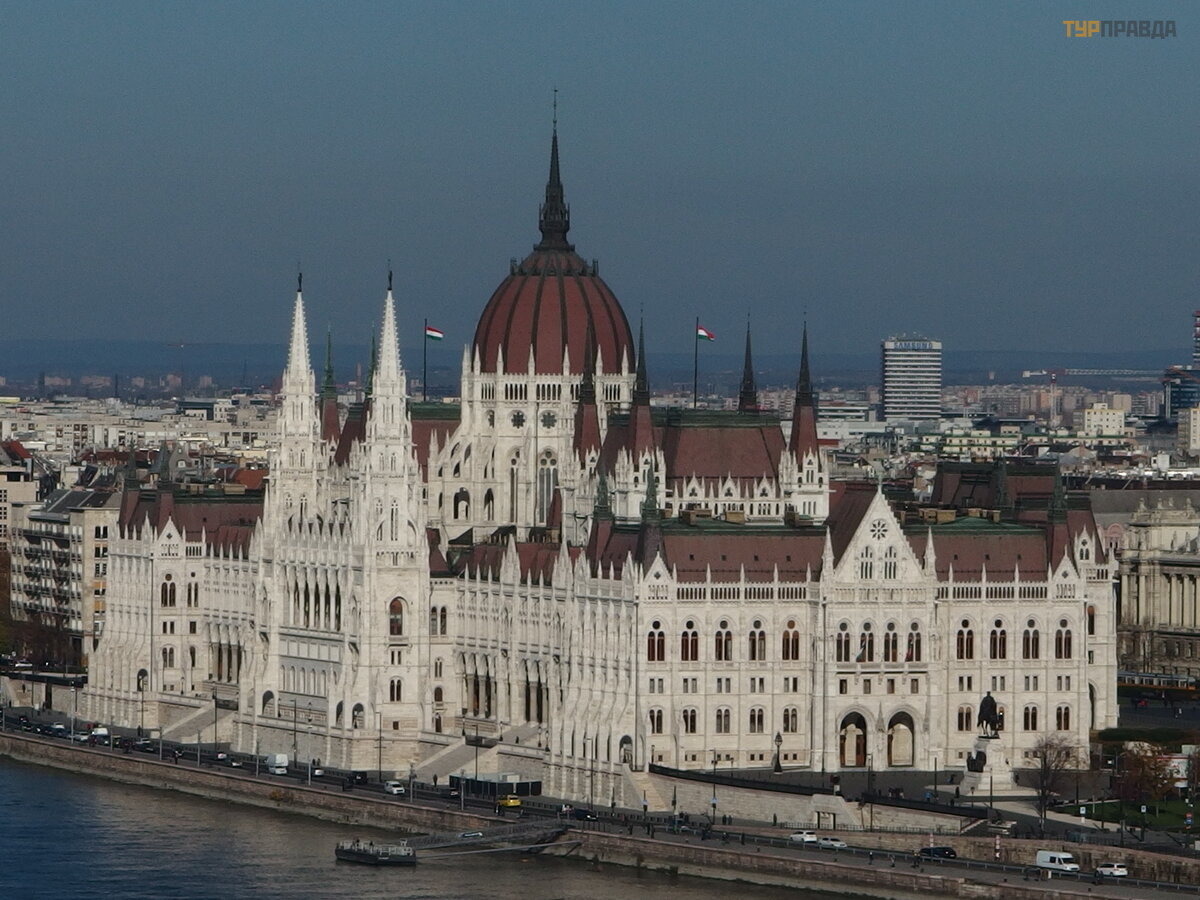
Красив при любой погоде:)
Здание венгерского парламента (1885-1904, Имре Штейндл) считается одной из визитных карточек Будапешта. До его постройки у венгерских законодателей не было своего постоянного места для заседаний. «Родина не имеет своего дома» – так в середине XIX века писал об этом поэт Михай Верёшмарти. После изгнания турок в 1686 году Законодательное собрание Венгрии было перенесено в Пожонь (совр. Братислава в Словакии). Однако в середине XIX столетия с ростом национального самосознания встал вопрос о том, чтобы венгерский парламент заседал в столице.
Работы начались в 1885 году. Место под будущее здание выбрали на берегу Дуная, где прежде была городская свалка. Учитывая сложный грунт, для начала пришлось укрепить его, залив под основание массивную бетонную плиту толщиной 2-5 м. Весь проект обошелся казне в 38 мл н золотых крон (на отделку интерьеров ушло 40 кг золота) – гигантская сумма по тем временам.
Здание имеет длину 268 м и ширину 123 м. Высота главного купола – 96 м (как и у базилики Св. Иштвана). Внутрь попасть можно через 27 входов. В парламенте – 29 внутренних лестничных переходов, 691 комната и 13 лифтов. Фасад украшен 90 статуями и изображениями гербов различных городов и провинций, а внутри – 152 статуи! Здание облицовано хрупким песчаником, который легко пачкается (поэтому постоянно приходится чистить фасады). К оформлению здания были привлечены лучшие венгерские художники, такие как Микша Рот, создавший витражи, Михай Мункачи, чье монументальное полотно «Обретение родины» украшает один из залов. Техническая «начинка» также была одной из передовых по тем временам.
Внутри помещений была установлена система кондиционирования воздуха, который в летнее время охлаждался в специальных подземных резервуарах со льдом. Главный вход, обращенный на площадь, «охраняют» фигуры львов.
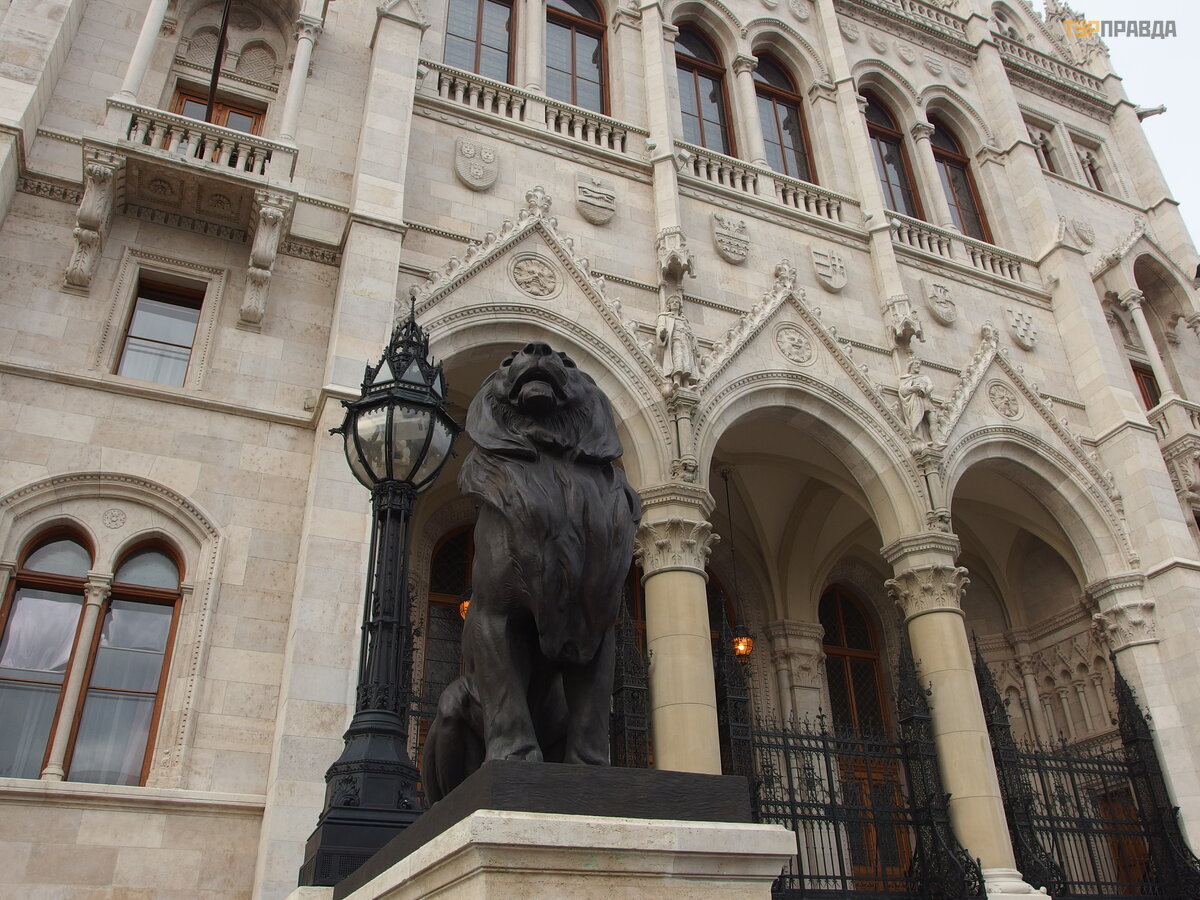
От него вверх устремляется парадная лестница, своды потолка которой украшены росписью, выполненной Кароем Лотцем. Эти фрески называются «Законотворчество» и «Апофеоз Венгрии».
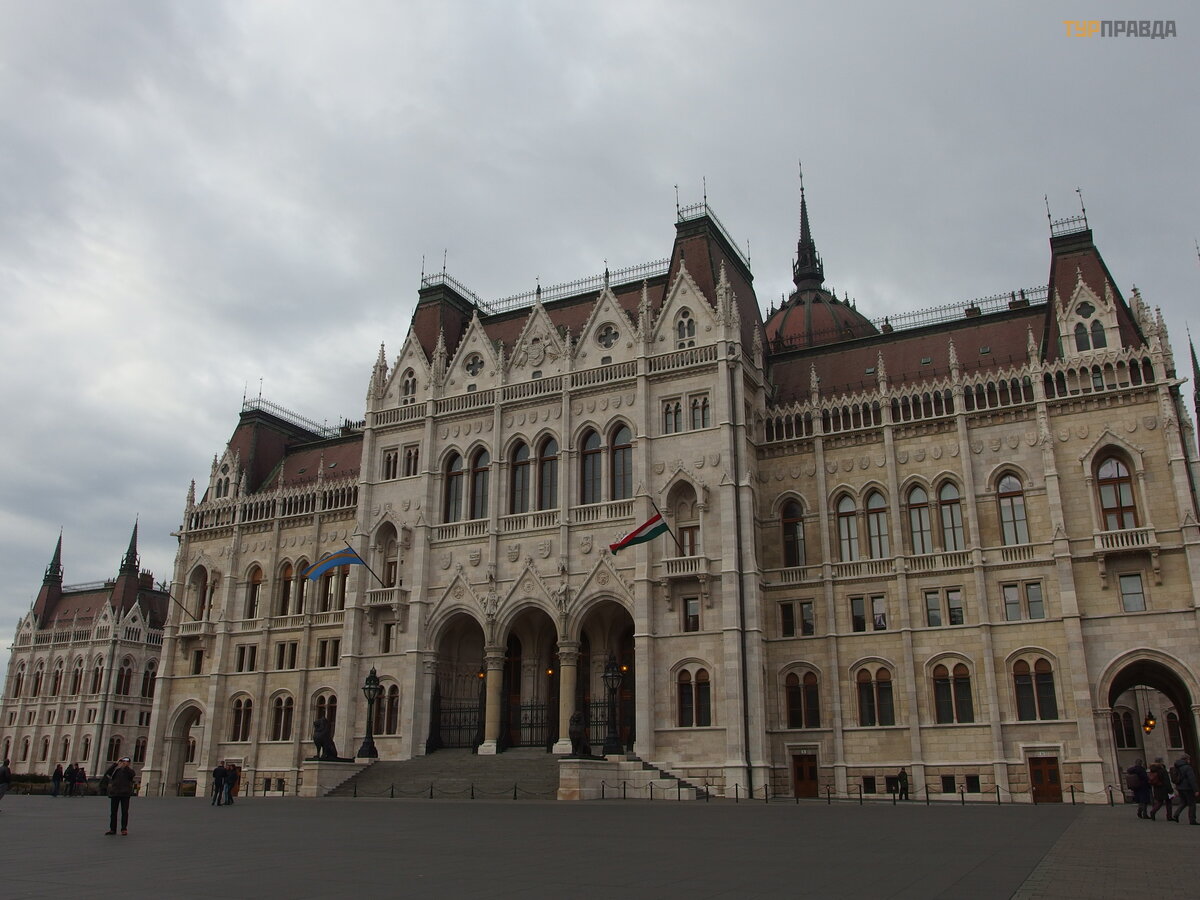
Лестница ведет к Купольному залу, высота которого составляет 27 м. По периметру на колоннах установлены 16 фигур видных правителей Венгрии: начиная от первого короля — святого Иштвана I и заканчивая императором Леопольдом II из династии Габсбургов. В центре зала под стеклом выставлены на обозрение венгерская корона и атрибуты королевской власти: держава, скипетр и коронационный меч.
От Купольного зала отходят два крыла, в которых размещались залы заседаний верхней и нижней палат. В современной Венгрии Законодательное собрание состоит только из одной палаты, где заседают 386 законодателей. Зал, где проходят их заседания, расположен в южном крыле. От Купольного зала его отделяет парадное фойе. Вдоль стен фойе устроено пять ниш, отделенных друг от друга колоннами с фигурами, изображающими представителей разных профессий. При этом архитектора изображает скульптура автора проекта самого здания – Имре Штеиндля. Потолок украшают фрески Жигмонда Вайда, иллюстрирующие древнюю историю венгров. Зал заседаний по форме напоминает подкову. На стене за президиумом – два полотна, на которых запечатлены важные моменты истории Венгерского государства: открытие Собрания народных представителей в 1848 году и коронация императора Франца-Иосифа в 1867 году. Между ними помещен национальный герб Венгрии в окружении гербов всех правивших в королевстве династий – Арпадов, Анжуйской династии, семьи Хуньяди, польского дома Ягелло, Запольяи и Габсбургско-Лотарингского дома. За залом заседаний расположены рабочие кабинеты премьер-министра и президента.
Зал в северном крыле здания, где прежде заседали представители верхней палаты парламента, используется для проведения всевозможных международных мероприятий, конференций, конгрессов. Полотна за президиумом посвящены объявлению королем Эндре II в 1222 году Золотой буллы и принесению присяги венгерского парламента на верность австрийской императрице Марии-Терезии в 1741 году.
От Купольного зала Зал конгрессов отделяет богато декорированное фойе, украшенное 32 аллегорическими фигурами, которые символизируют профессии, связанные с сельским хозяйством, животноводством, промышленностью, торговлей, различными науками и искусством. Фрески на потолке работы Жигмонда Вайды представляют сцены из истории: «Святой Ласло дарует людям лечебную траву от чумы», «Король Кальман Книжник запрещает сжигание ведьм», «Аббат Астрик передает королю Иштвану I корону», «Аллегория о славе креста»,«Король Матьяш среди народа», «КорольЛайош I Великий поручает строительство собора в городе Кашша».
Здание парламента сильно пострадало во время Второй мировой войны: в 1944-1945 годах в него попало около 250 авиабомб. Тем не менее здание удалось полностью восстановить. В советские годы шпиль главного купола украшала пятиконечная звезда, подобная звездам Московского Кремля. Площадь перед зданием парламента часто используется в дни государственных праздников. Здесь проходят военные парады, сопровождаемые церемонией поднятия государственного флага. На площади венгры выражают свое недовольство политикой властей. Здесь же установлены памятники выдающимся борцам за свободу.
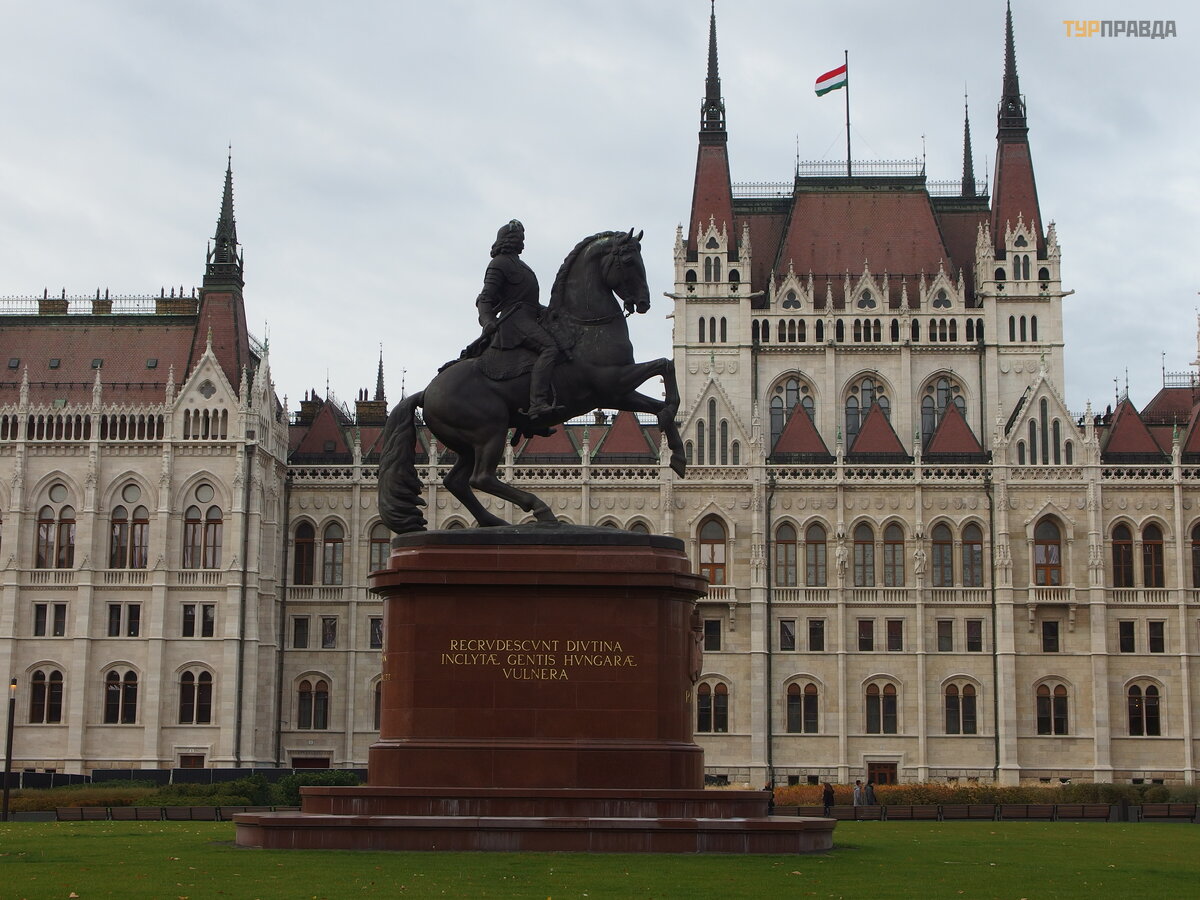
В южной части площади – конный памятник Ференцу Ракоци (1676-1735) (1936, Янош Пастор), который был предводителем антигабсбургской национально-освободительной войны начала XVIII века. На одной стороне постамента высечен девиз крестьян-повстанцев: «За родину и свободу». На другой – слова Ракоци: «Снова воспаляются извечные раны венгерского народа».
С противоположной стороны на героя крестьянской войны смотрит Лайош Кошут(1802-1894) – участник революции и освободительной войны 1848 года. Памятник ему был установлен в 1927 году. Однако он не нравился послевоенному коммунистическому диктатору Венгрии Матьяшу Ракоши, который считал его «депрессивным». В итоге памятник демонтировали, а на его месте в 1952 году был воздвигнут более «жизнеутверждающий» монумент, напоминающий типичные советские памятники героям-революционерам.
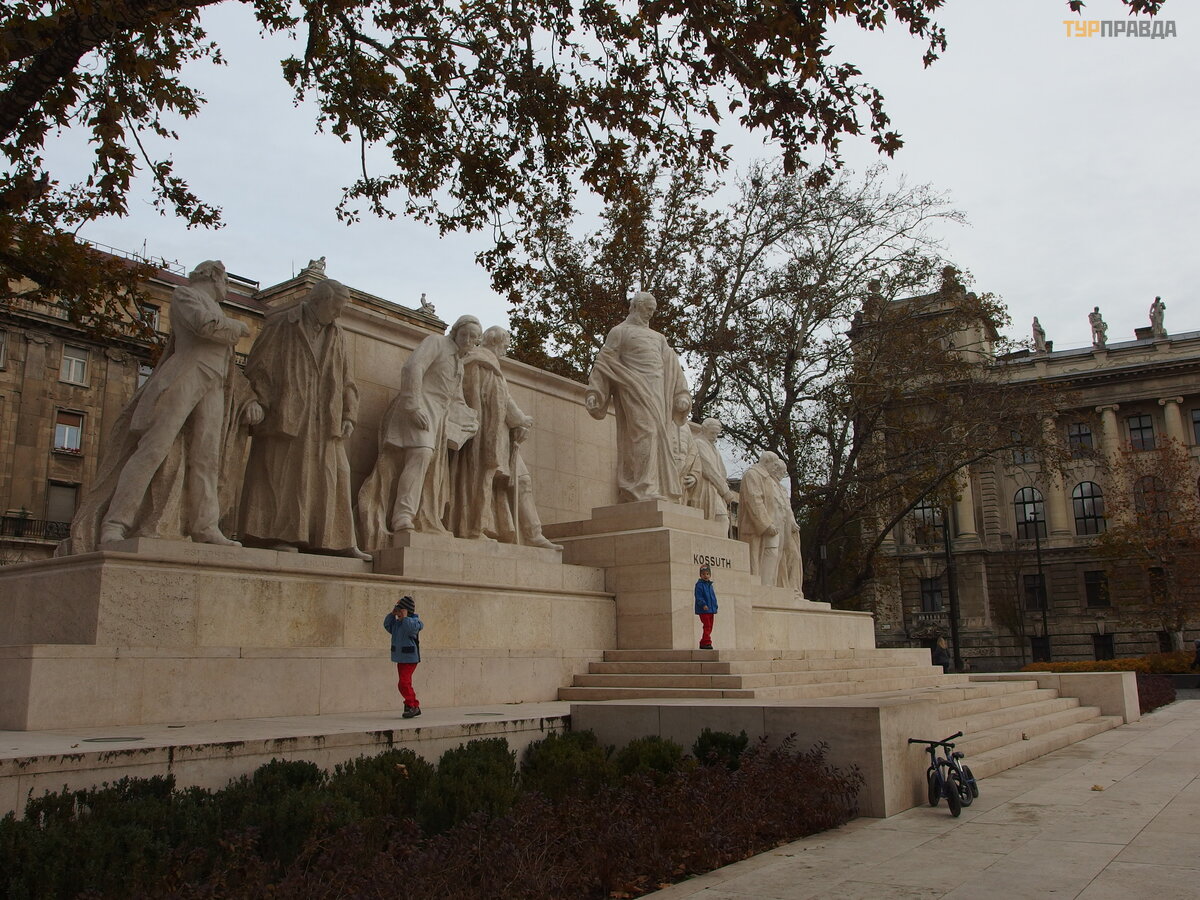
Пройдя вход в музей парламента вы увидете памятник Иштвану Тисе (gróf Tisza István). Иштван Тиса (1861-1918) – венгерский политический деятель, премьер-министр Королевства Венгрия. Получил известность добившись перезахоронения останков Ференц II Ракоци. Читая его биографию задаешься вопром:"А чего больше он принес венграм вреда или пользы?" Современники люто его ненавидили. На него было три неудачных покушения, а четвертое удалось. А потомки поставили памятник.
Памятник графу Тисе работы скульпторов Дёрдя Залы и Антала Орбана был открыт 22 апреля 1934 г. (22 апреля – день рождения Тисы). Весной 1945 памятник был разрушен. До недавнего времени на этом месте стоял памятник Михаю Каройи – "левому" премьеру и президенту Венгрии, пришедшему к власти как раз в результате той самой революции, которая убила графа Тису. И при котором Венгрия потеряла почти всё, что могла потерять, точнее по Версальскому мирному договору 1918 г.
Памятник Каройи убрали. А на его месте восстановили копию старого памятника графу Тисе (скульптор Иштван Элек).
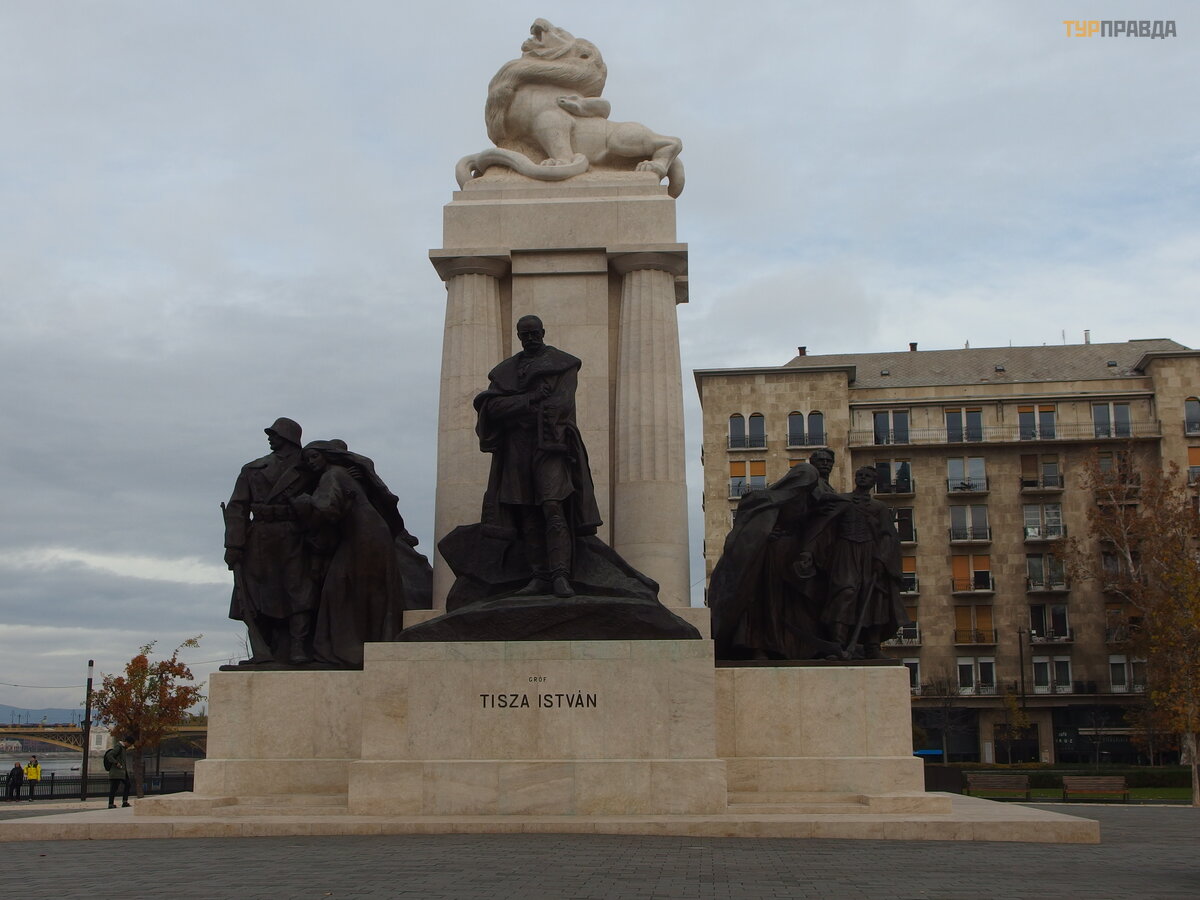
Возле памятника Ференца Ракоци спустившись под площадь можно посмотреть мемориал жертвам Венгерского востания 1956 г.
А пройдя ближе к набережной еще два памятника: Графу Дьюле Андраши де Чиксенткирайи и Краснагорка (Дьюла Андраши-старший, венг. Andrássy Gyula; 3 марта 1823, Олахпатак, Австрийская империя – 18 февраля 1890, Волоска, совр. Опатия, Австро-Венгрия) – венгерский государственный и политический деятель. Активный участник венгерской революции за независимость 1848-1849 гг.
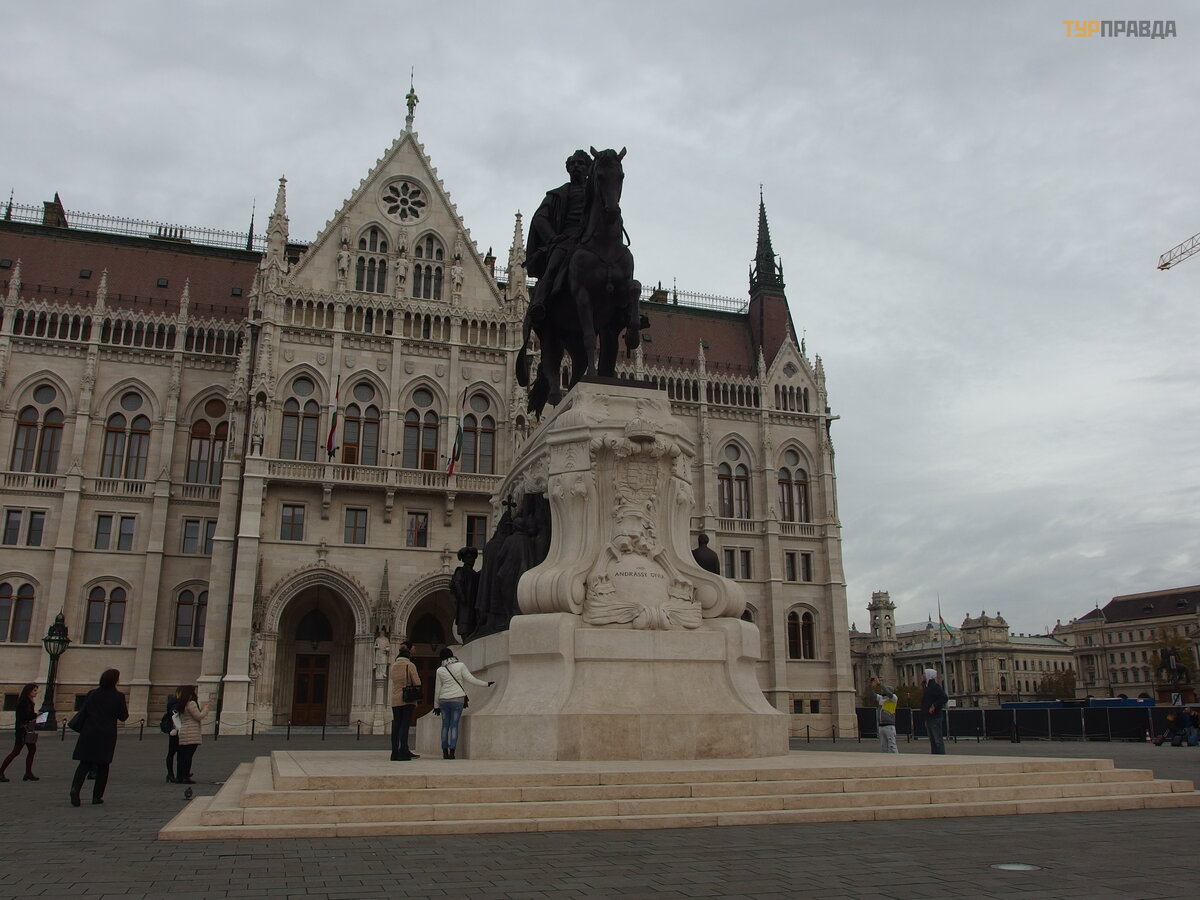
И венгерскому поэту Йожефу Аттиле.
Поэт изображен сидящим на ступеньках набережной со шляпой в руке, на памятнике выгравированы строки его стихов о Дунае. Аттиле Йожефу было всего 32 года, когда он покончил с собой, бросившись под поезд. Это настоящий классик венгерской поэзии. Не случайно, что День поэзии в Венгрии отмечается именно 11 апреля, в день рождения Аттилы Йожефа.
С этим памятником была целая история. Во время реконструкции площади его собирались убрать, но горожане устроили в ноябре 2011 года «Йожеф Аттила Марафон» – всю субботу и всю ночь на воскресенье, 32 часа подряд, по числу прожитых им лет, один за другим на площади читали его стихи.
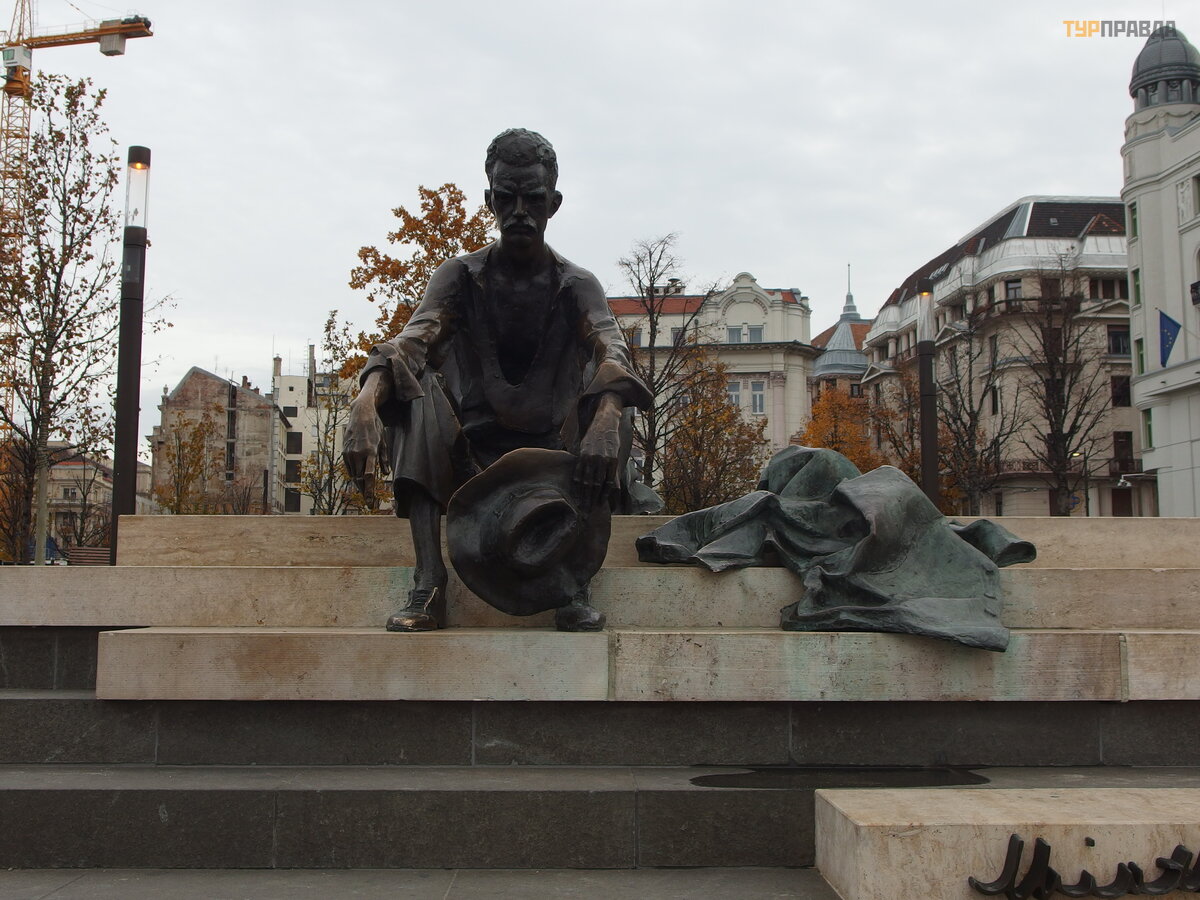 А?ттила Йо?жеф (венг. József Attila; 11 апреля 1905 (1905-04-11), Будапешт – 3 декабря 1937, Балатонсарсо)
А?ттила Йо?жеф (венг. József Attila; 11 апреля 1905 (1905-04-11), Будапешт – 3 декабря 1937, Балатонсарсо)
На набережной Дуная перед зданием парламента на мощеном тротуаре можно увидеть 60 пар металлических башмаков и туфель. Это мемориал памяти жертв Холокоста (2005, Дьюла Пауэр и Кэн Тогэй), посвященный памяти евреев, расстрелянных на этом месте венгерскими фашистами в 1944-1945 годах.
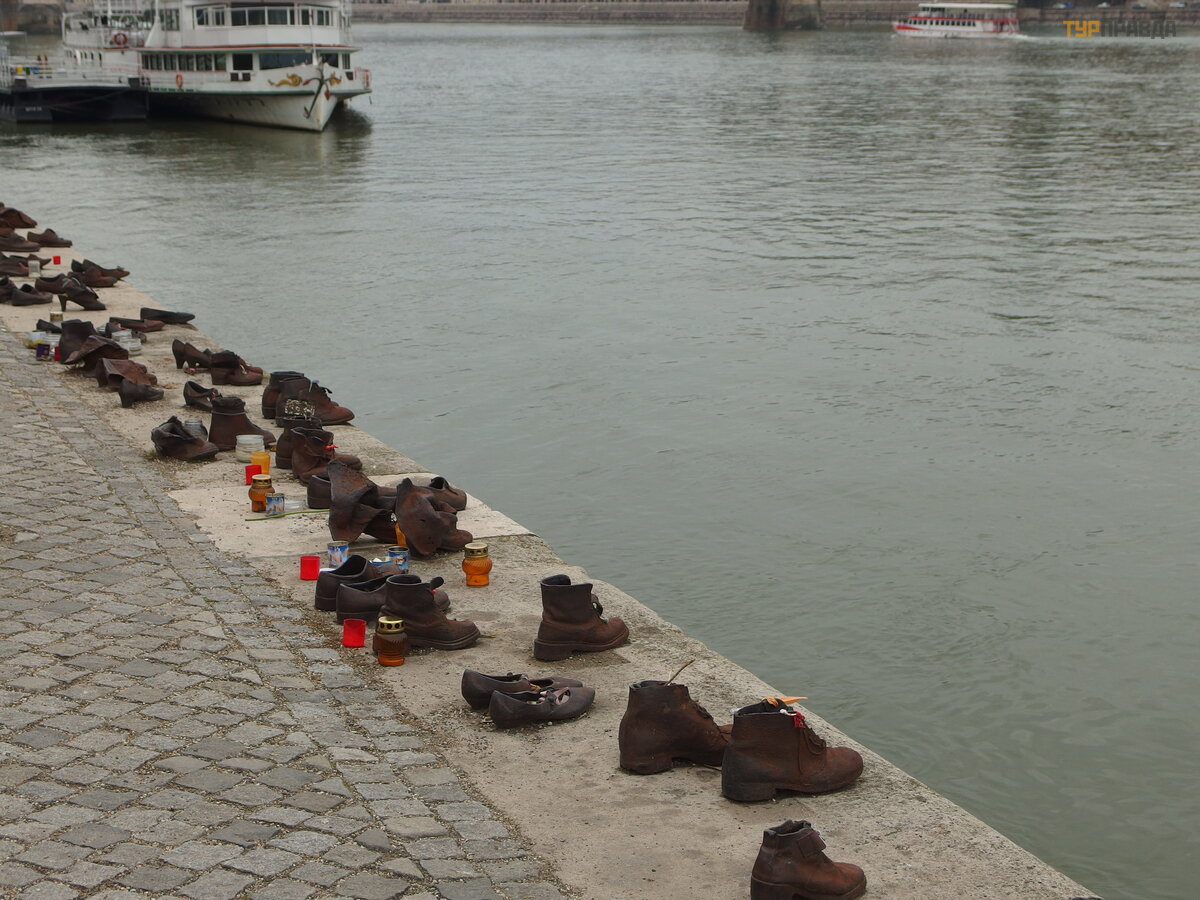
С торца здания Министерства сельского хозяйства видно площадь Вертанук (Vertanuk tere, Мучеников), в центре которой, в маленьком сквере расположена необычная скульптурная композиция. На перекинутом через искусственный ручей мосту стоит бронзовая фигура человека в шляпе, его грустный взгляд обращен на величественное здание парламента. Это памятник Имре Надю(1896-1958)(1996 Тамаш Варга) – венгерскому государственному деятелю, который занимал пост премьер-министра во время трагических событий в Венгрии осенью 1956 года. Он поддержал и возглавил восстание 1956 г.
Спросите себя , а найдется ли сейчас в нашем правительстве человек , который не задумываясь отдаст жизнь за идею свободы и независимости своей страны. Надю обвинили "в государственной измене" и повесили. Возможность попросить помилование у него была, но он от нее отказался заявив, что история и мировое коммунистическое движение рассудят, кто был прав.
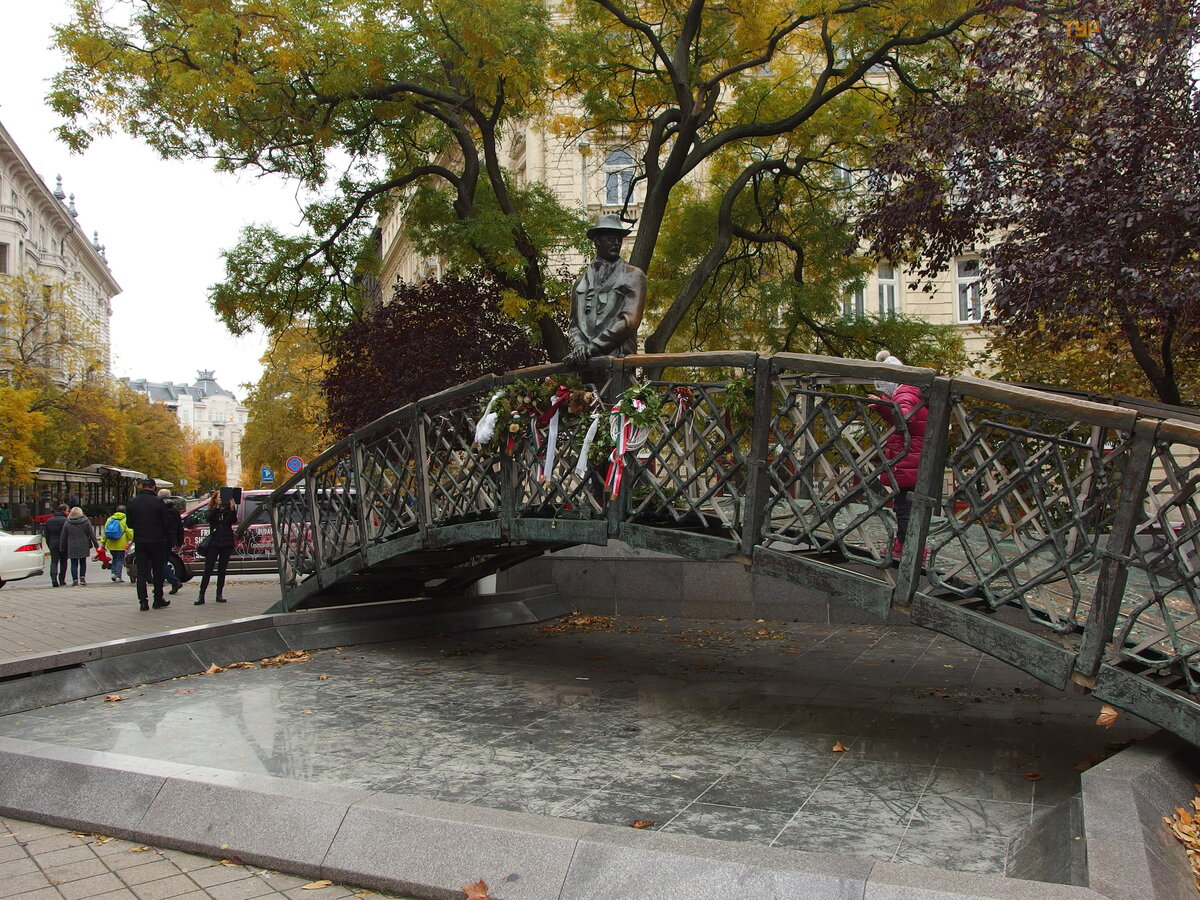
Продолжая прогулку по Липотварошу (так называется этот район Будапешта) по улице Vecsey виходим на площадь Свободы.
Под землей (почти под этой улицей) между площадью Свободы и расположенной по соседству площадью Кошута находится бывший бункер коммунистического диктатора Венгрии Матьяша Ракоши, называвшего себя «лучшим верным учеником Сталина». Строительство началось в 1949 году и закончилось в 1953-м. Бункер, рассчитанный на 2200 человек, предназначался для укрытия высшего руководства Венгерской рабочей партии в случае ядерного удара. Он был соединен с расположенным поблизости зданием парламентам имел вы ходы в проходящую рядом линию метро, которая, по задумке, могла использоваться для эвакуации руководства страны в другое безопасное место. После окончания холодной войны бункер оказался заброшен. Сегодня он принадлежит государству и относится к стратегическим объектам безопасности.
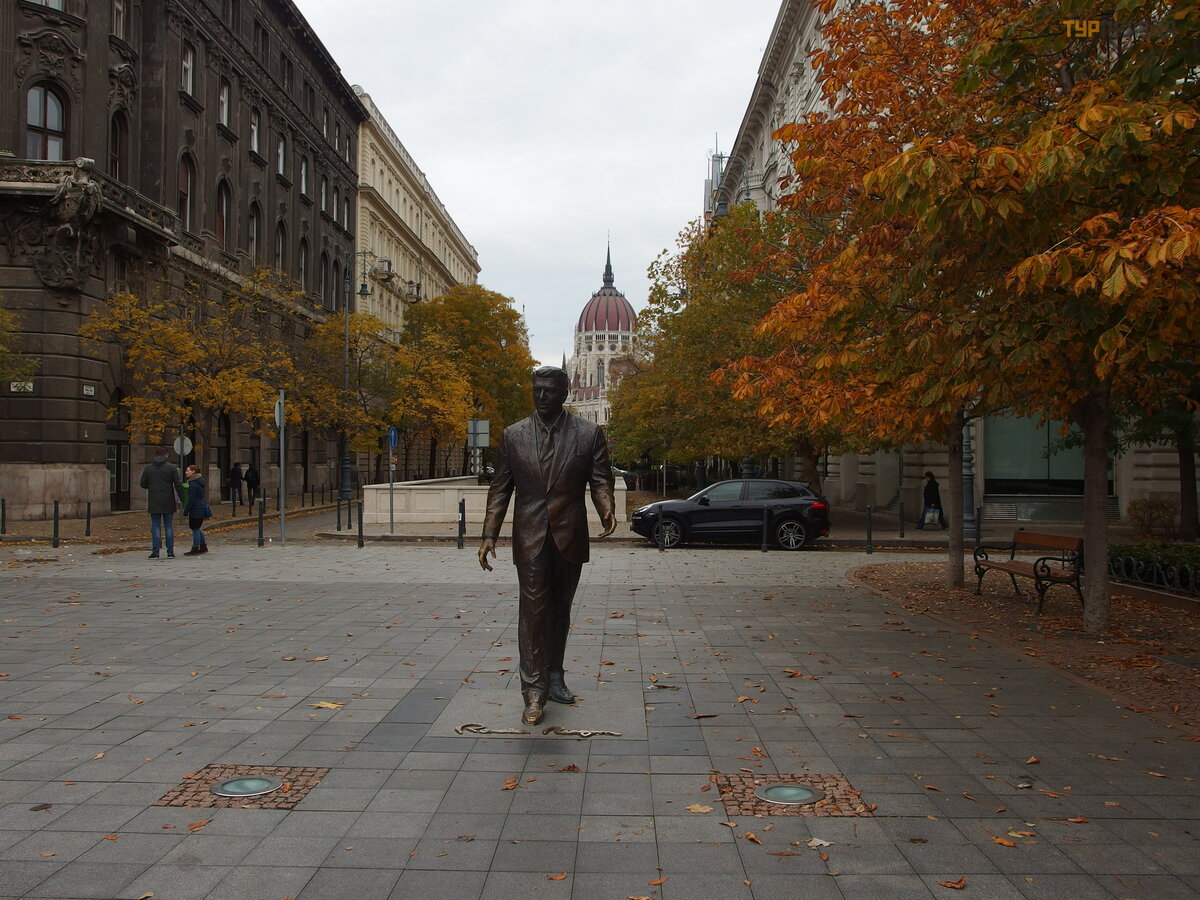
Очень символично, на площади Свободы в нескольких метрах от мемориала советским воинам, павшим во Вторую мировую установлен памятник Рональду Рейгану – политику и президенту США. Он был открыт в 2011 году. Рейган сыграл огромную роль в завершении "холодной войны", в результате которой Венгрия получила независимость. На церемонии открытия монумента присутствовали сотни местных жителей.
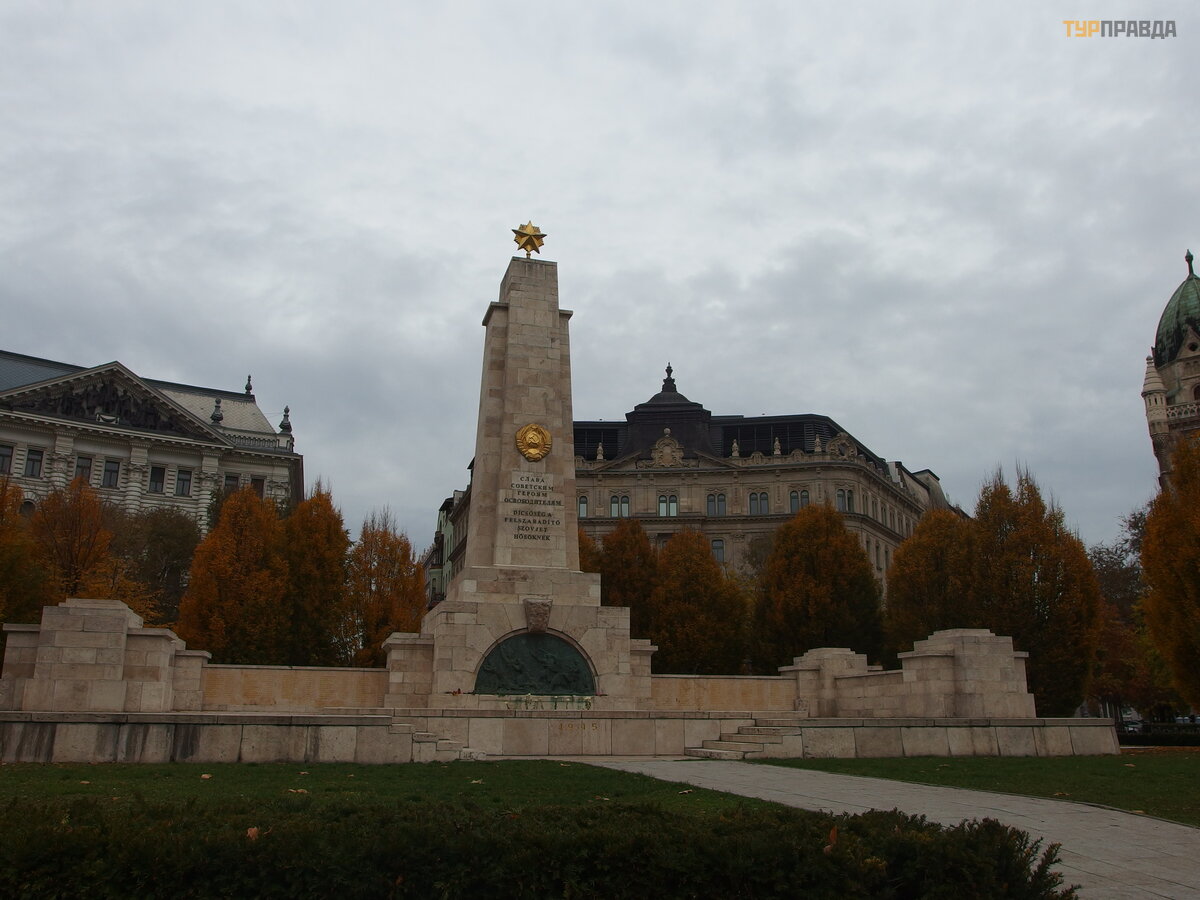
Историческая спавка:
На этом месте располагался комплекс казарм Нойгебоде, где размещались стрелки австрийского гарнизона. Во время войны за независимость 1848-1849 годов здание использовалось как тюрьма, куда были заключены многие участники национально-освободительного движения, часть которых была казнена во внутреннем дворе. Среди них был и первый премьер-министр Венгрии Лайош Баттьяни. С тех пор для венгров это здание стало своеобразной «Бастилией», а память о нем до сих пор ассоциируется с силой и жестокостью, направленными на подавление стремлений к независимости.
В 1897 году ненавистное здание снесли, а на его месте решили сделать площадь Свободы. Ее застроили роскошными дворцами, спроектированными лучшими архитекторами.
С западной стороны площадь обрамляет бывшее здание фондовой биржи (1897-1907, Игнац Алпар), которое на рубеже столетий считалось самым крупным подобным сооружением в Европе.
Монументальное эклектичное здание, первоначально построенное для Будапештской фондовой биржи, было спроектировано и возведено по проекту архитектора Игнаца Алпара (1897-1907). Это был самый большой в своем роде дворец в Европе, символизирующий деньги, богатство и власть.
Первая в Будапеште фондовая биржа была основана в 1854 году во дворце Ллойда/Lloyd palota, который располагался на южном конце площади Рузвельта/Roosevelt tér. В 1893 году биржа переехала в здание на площади Свободы. Строительство нового здания Фондовой биржи началось в 1902 году и было полностью завершено в 1907 году. 25 мая 1948 года биржа закрылась. Позже здесь был создан Институт Ленина и Дом техники, где располагались штаб-квартиры научных ассоциаций. Венгерское телевидение переехало сюда в 1955 году, а в 1960-е годы получило его в свое полное распоряжение. Через несколько десятилетий после многочисленных перепланировок дворец сильно изменился, его оригинальный первозданный внутренний вид теперь можно увидеть только на архивных фотографиях
С восточной стороны на площадь обращен фасад Национального банка Венгрии (1902-1905, Игнац Алпар), за которым следует американское посольство.
А с восточной стороны американского посольства можно обнаружить одно из самых живописных зданий Пешта – почтамт-сберкассу Сберегательного почтового банка (Postatakarék-pénztár). Здание было возведено в 1899-1902 годах по проекту знаменитого архитектора Эдена Лехнера и считается родоначальником нового стиля, сочетающего стандарты модернизма с элементами национальных мотивов. А украшенная цветами, крыльями ангелов, драконьими хвостами и другими экзотическими мотивами крыша вообще не имеет аналогов – когда мастера спросили, зачем столь богатая отделка в совершенно не видимом с улицы элементе, он ответил: "А почему бы птицам не полюбоваться ими?".
После Первой мировой войны, завершившейся для Венгрии национальной трагедией (страна потеряла две трети своих территорий и треть населения), в северной части площади появились монументы, символизировавшие утраченные земли. 1 мая 1946 года на их месте был установлен памятник советским воинам-освободителям (1946, Антал Карой), павшим при освобождении Будапешта. Сегодня он является единственным оставшимся в городе монументом бойцам Красной армии. Остальные после революции в 1989 году были либо перенесены на городское кладбище, где захоронены павшие советские солдаты, либо попали в парк скульптур советского периода. Некоторые местные организации ведут сбор подписей за снос этого памятника и возвращение на его место первоначального монумента.
Чуть в стороне, в тени деревьев напротив здания американского посольства можно видеть скромный по размерам бронзовый памятник американскому генералу Гарри Хиллу Бандхольтцу (1864-1925) (1936, Миклош Лигети), в одночасье ставшему венгерским национальным героем. В октябре 1919 года он возглавлял миссию союзников Антанты по разоружению Венгрии и контролю над выводом из страны румынских войск. Вечером 5 октября оккупировавшие Будапешт румынские военные попытались вывезти сокровища Национального музея. Узнав об этом, генерал Бандхольтц немедленно направился к музею и спас от разграбления его коллекцию (согласно легенде, он остановил румынских солдат, будучи вооружен лишь хлыстом). Кроме этого, он уберег мебель королевского дворца и помешал румынским властям арестовать премьер-министра Венгрии Иштвана Фридриха. У себя на родине Бандхольтц считается «отцом» военной полиции в армии США.
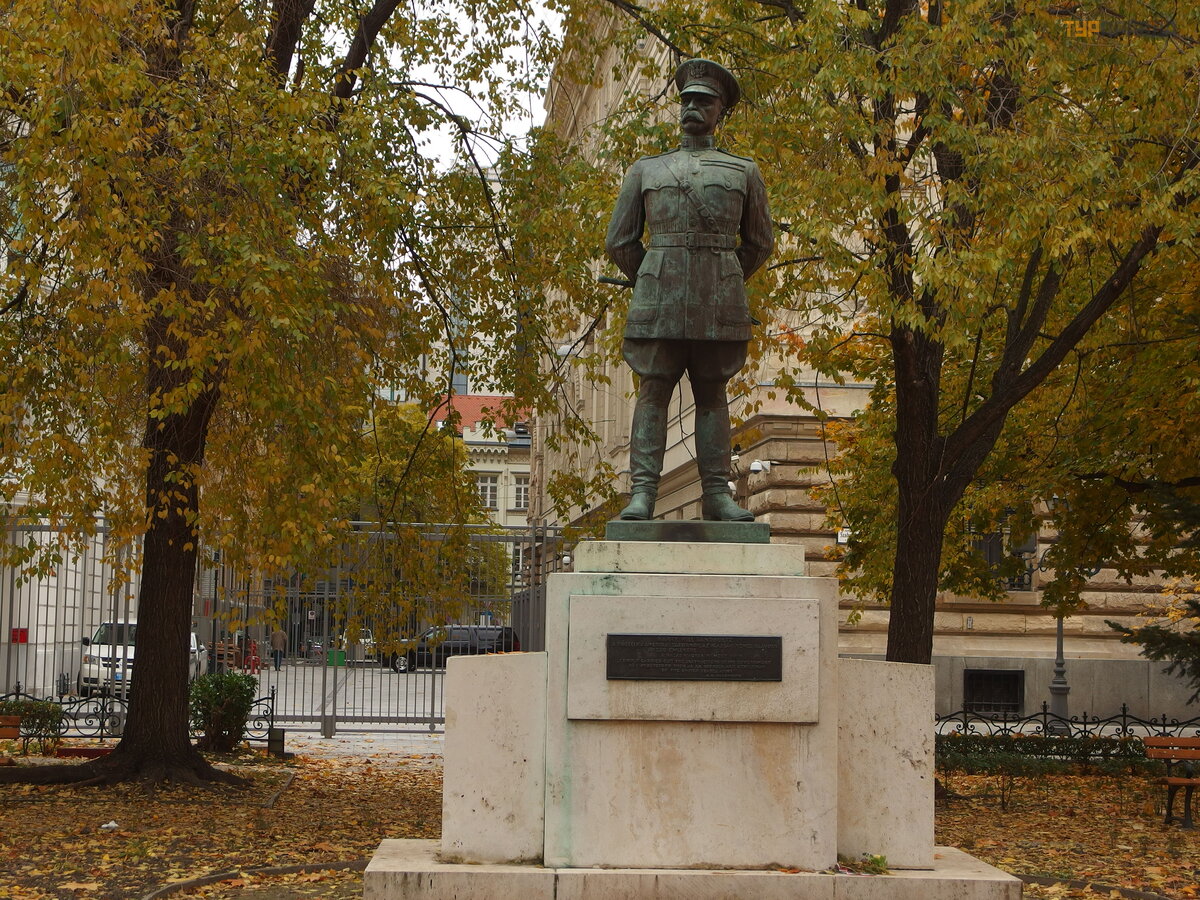
И завершает площадь памятник жертвам немецкой окупации:
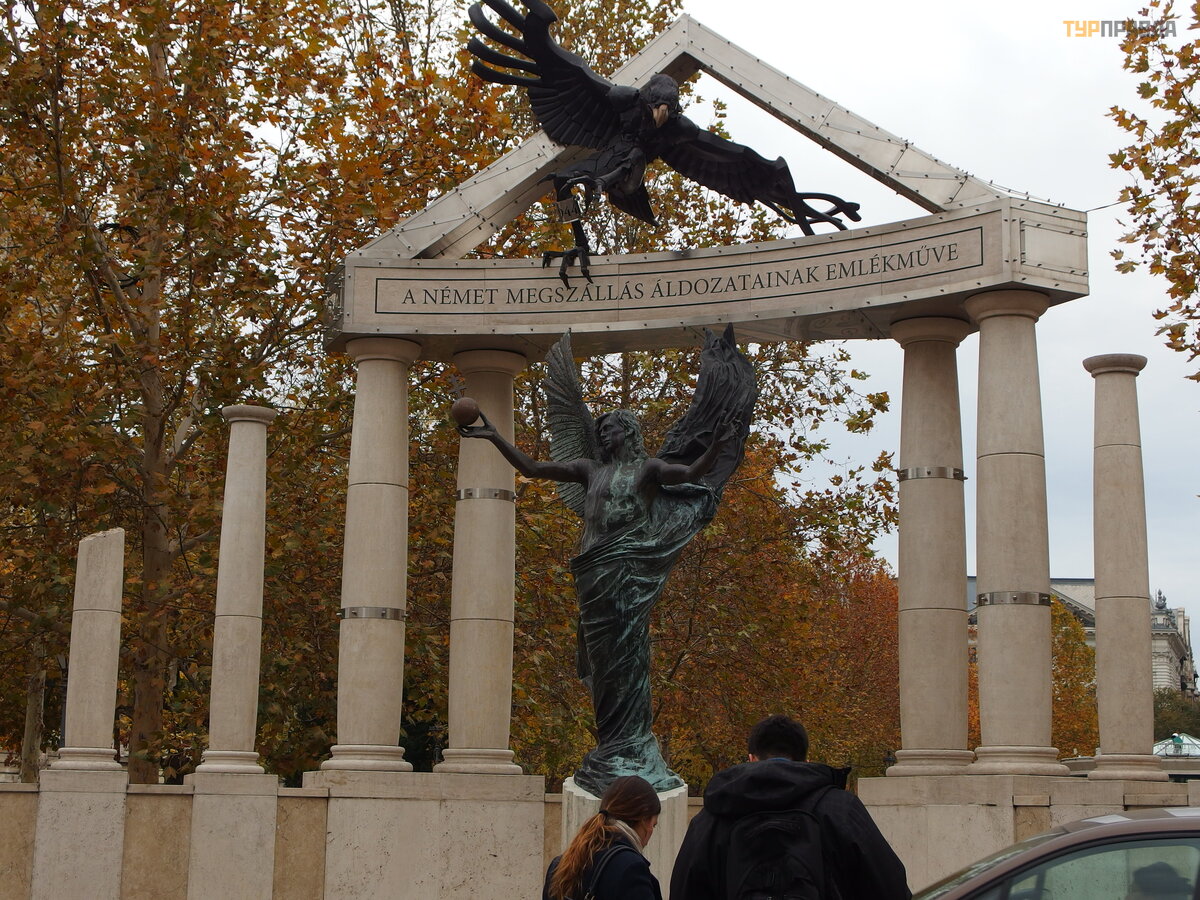
От площади Свободы возвращаемся к Дунаю, и направляемся к Цепному мосту.
Всего в Будапеште 9 мостов, 2 из них – железнодорожных: Цепной (Львиный) Мост, Мост Эржебет, Мост Свободы, мост Маргит, Мост имени Шандора Петёфи, мост Ланцхид, мост Арпад.
Цепной мост (Львиный), или мост Сечени – самый «центральный» мост, потому что ведет от Парламента к Будайской крепости. Его еще называют «Старая дама». Это первый постоянный мост на Дунае, являющийся также одним из символов Будапешта. Во время Второй мировой войны мост был взорван немцами, а после восстановления открыт 20 ноября 1949 года - день в день через сто лет после первой сдачи. От моста начинается тоннель под Крепостной горой, который по длине – 350 метров – равен длине моста. Есть даже такая трогательная шутка: мост во время дождя убирают в тоннель.;)
Инициатором постройки моста выступил граф Иштван Сечении, который был вынужден прождать целую неделю, пока нашелся смелый лодочник, который отважился отвезти графа из Пешта в Буду, лавируя между огромных льдин. И тогда граф заявил, что готов отдать свой годовой доход на строительство постоянного каменного моста через Дунай, и, конечно, мост был построен(по проектам Вильяма Тирни Кларка и его однофамильца строителя Адама Кларка в период 1839-1849 г.), а чуть позже – и тоннель. Цепной мост официально носит имя графа Сечени. Неотъемлемой частью моста являются величественные фигуры львов (скульптор Я. Маршалко). Поначалу горожане их не приняли, упрекая скульптора за отсутствие языков в львиных пастях. В ответ на что Маршалко опубликовал статью: «Львы – не собаки, и языки из пасти у них не свисают». Особенно эффектно выглядит мост и открывающаяся с него панорама города вечером, когда включают иллюминацию.
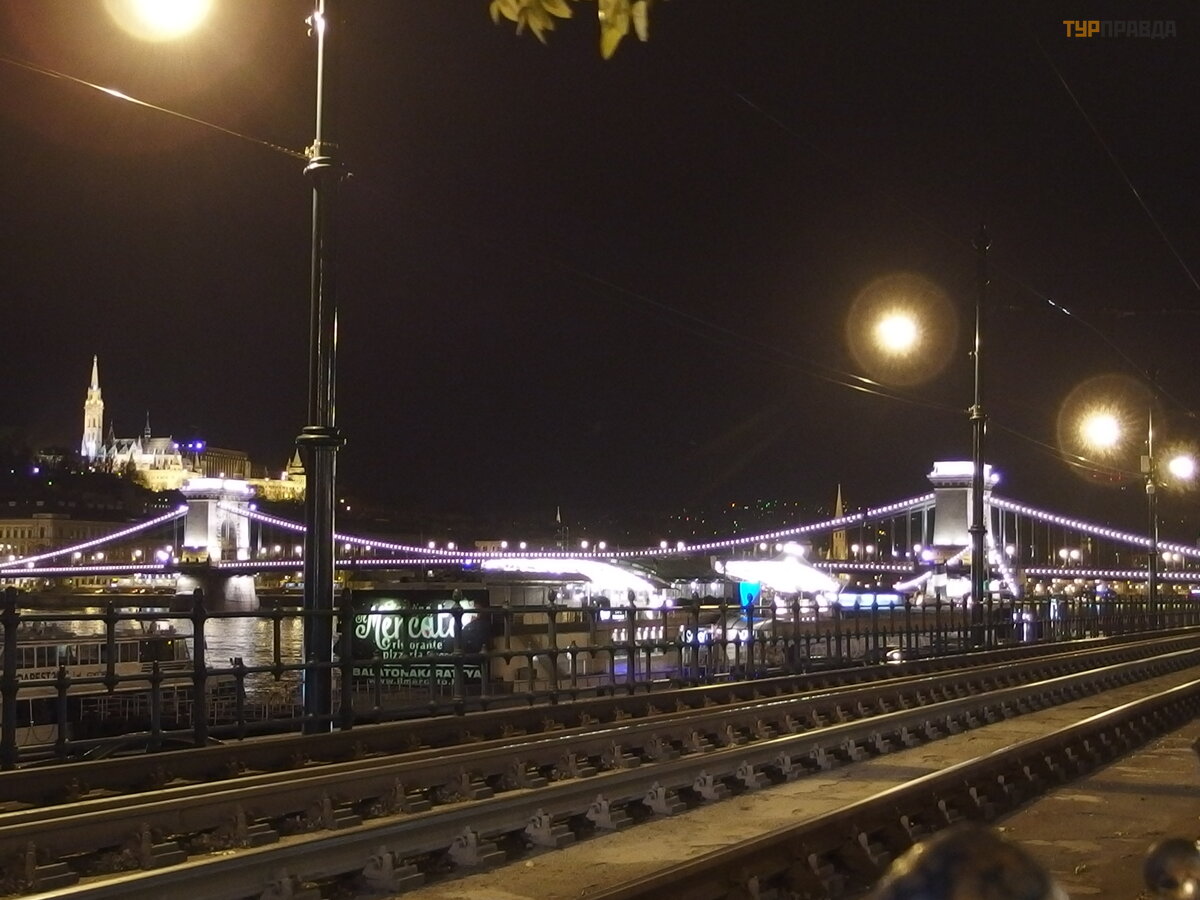
Выходим к небольшому скверу перед мостом, и подходим ко дворцу Грешем (Gresham Palace):
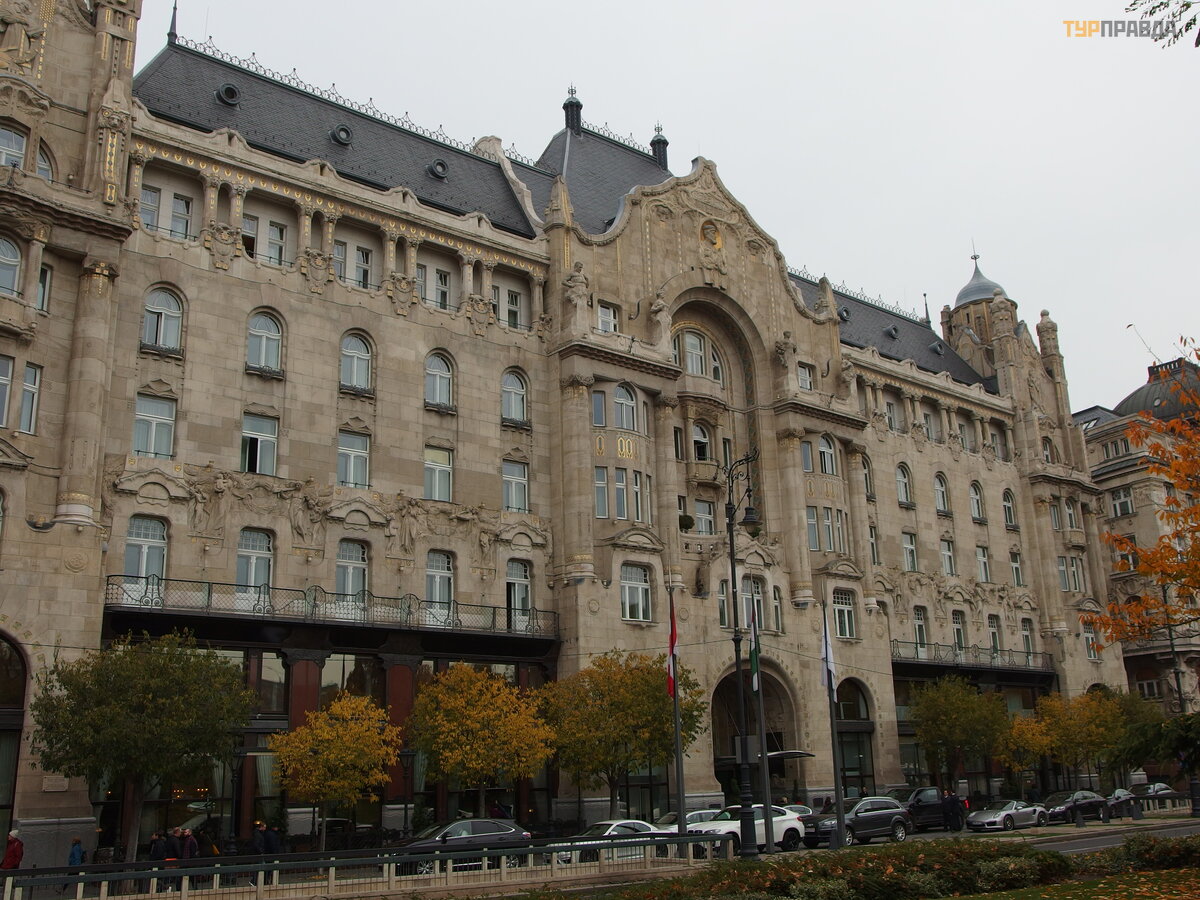
Одним из величайших примеров венгерского модерна является дворец Грэшема. Площадь, которую занимает дворец, составляет 12 тысяч квадратных метров. Когда-то он был одним из самых больших жилых зданий. Стиль, в котором он построен, называется – сецессион (Secession ) периода модерн. Сейчас в помещении дворца расположился отель «4 seasons».
Согласно историческим данным на месте дворца находился обычный большой частный дом, тогда его называли – дворец Нако (Nakó-palota). В 1880 году лондонская страховая компания, главой которой был Томас Грэшем, приобрела это строение. Предполагалось, что в нем будет находиться представительство компании, но в 1904 дворец Нако был снесен. В 1905 был объявлен конкурс на лучший проект нового здания. Из многочисленных заявок была выбрана работа венгерского архитектора Жигмонда Квиттнера, и в 1907 на набережной вырос новый дворец, поражающий своей величиной и убранством.
Здание было украшено аллегорическими фигурами, панно из мозаики, отделкой из кованого железа и растительным орнаментом. Все это должно было подчеркнуть благосостояние Британской империи, родины Грэшема.
Это одно из самых красивых мест в городе. Не зря было выбрано место расположения дворца. Из центральных окон, украшенных резным рисунком, хорошо видны просторы Дуная и живописный берег. Фасадная часть здания украшена бюстом Томаса Грэшема, работу которого выполнил Эде Тельча.
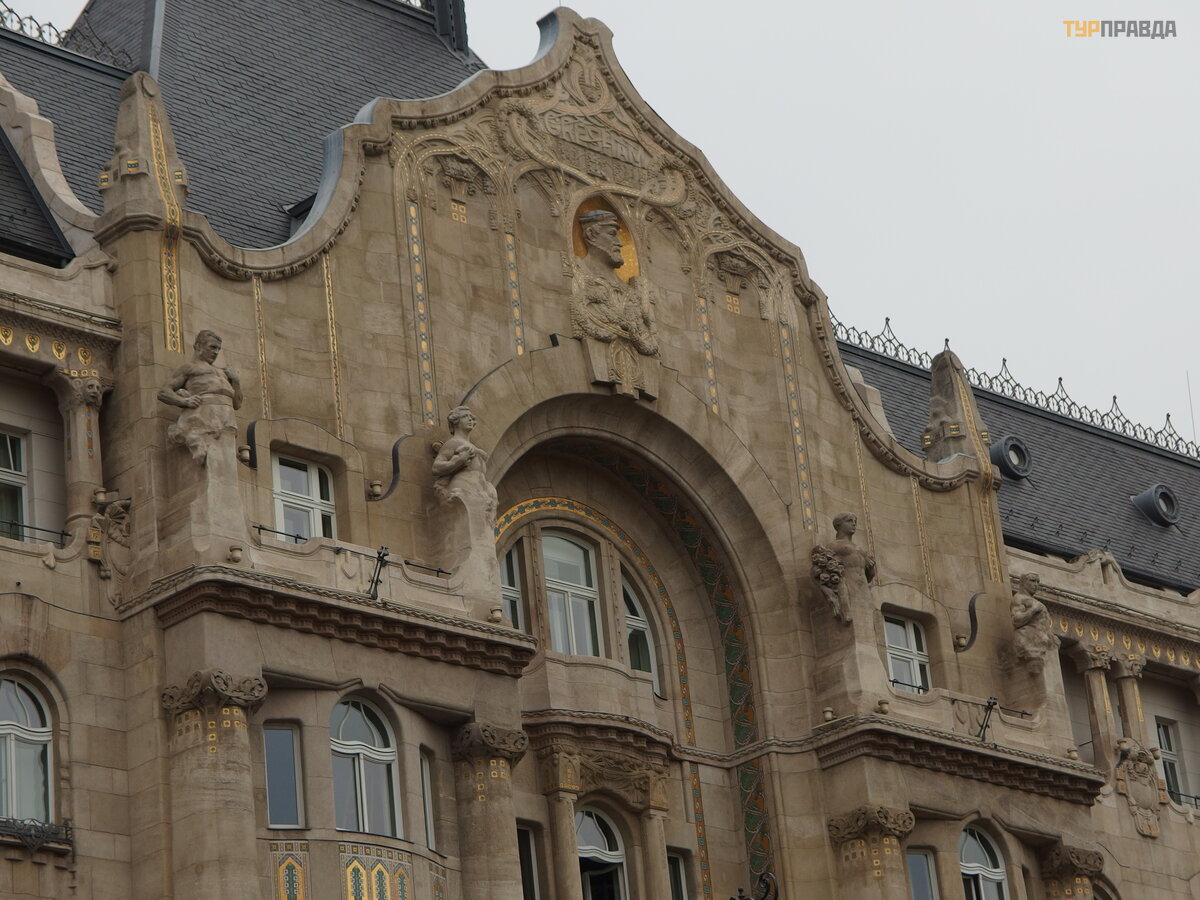
Пол дворца украшает мозаичная плитка. Ее изготовила фабрика Жолнаи (Zsolnay Porcelánmanufaktúra), на тот момент лидирующая в своей области. Позолота стен особенно прекрасна в лучах заходящего солнца, она подчеркивает богатое убранство здания.
Первый этаж дворца Грэшема выполнен в виде буквы «Т» и имеет арочную галерею с прозрачной крышей. В ней располагались несколько магазинов и ресторан, предлагающий попробовать изысканные венгерские блюда. За удобными столиками собирались члены «кружка Грэшема» – закрытого клуба венгерской творческой интеллигенции. Такого рода пассаж был единственным в Будапеште, и все дамы из высшего общества предпочитали делать покупки именно здесь. Дворец Грэшема в Венгрии считался самым модным местом. В здании имеются три основные лестницы, которые были названы в честь графа Дьюлы Андраши, Томаса Грэшема и Лайоша Кошута. В промежутках лестничных клеток горели ярким светом огромные витражные окна, в центре которых красовались портреты этих выдающихся людей. Кстати, эти витражи являются работой гениального Микши Рота.
Мировой кризис повлиял на деятельность многих компаний, в том числе и на компанию Грэшема. В 1939 году пришлось закрыть представительство. Во время второй мировой войны дворец сильно пострадал. Из-за взорвавшихся снарядов были повреждены крыша пассажа и витражные окна. После окончания войны в 1948 году правительство Венгрии приватизировало здание. Продолжительное время никто не занимался реставрацией. В здании долгое время находилась библиотека, потом представительства различных государств, а в 70-х годах сооружение отдали под коммунальные квартиры.
После падения коммунистического режима здание дворца снова было приватизировано. Долгие годы велись реставрационные работы. И наконец в 2004 году дворец Грэшема открылся, но уже как отель «Four Seasons Gresham Palace». В 2011 году его купил Султанат Омана. В 2005 году закончилась очередная глобальная реставрация, в ходе которой удалось восстановить практически первоначальный вид дворца.
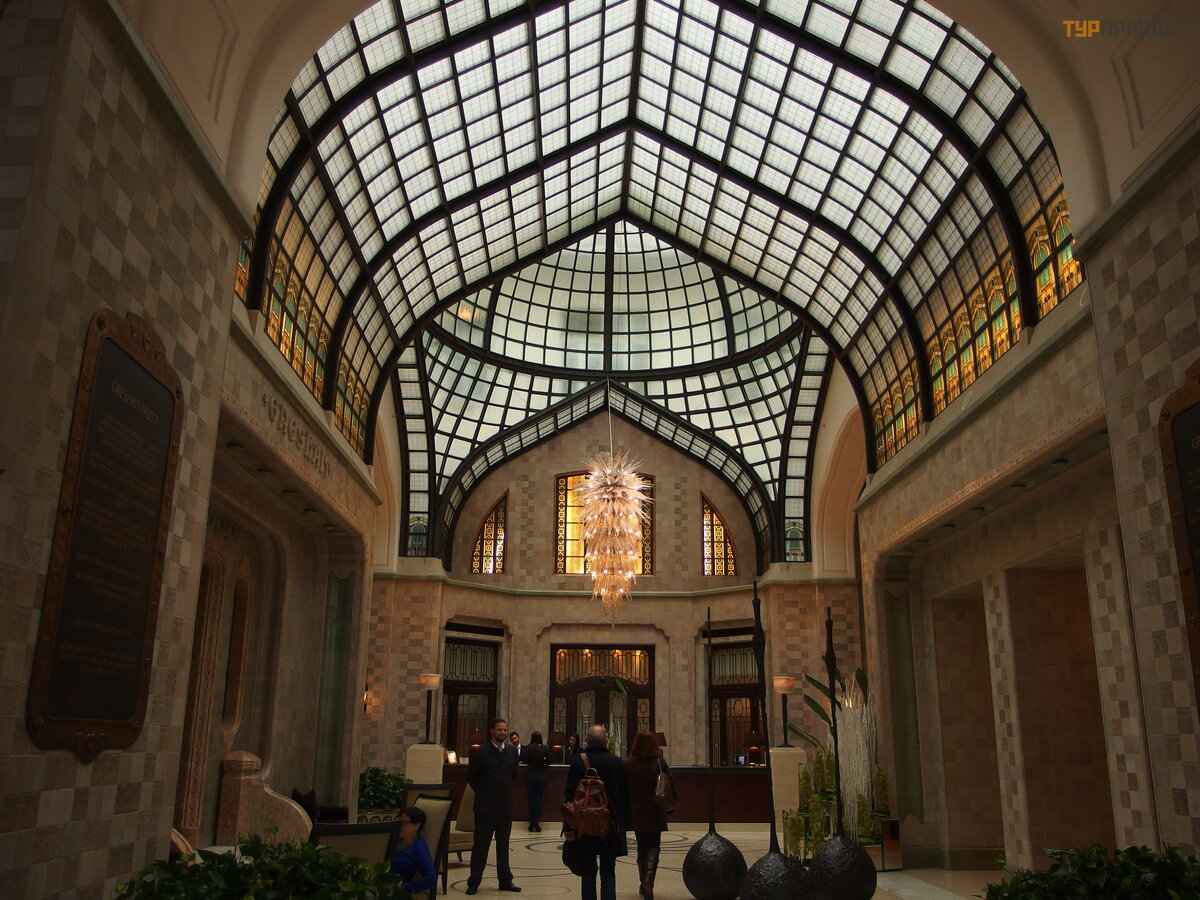
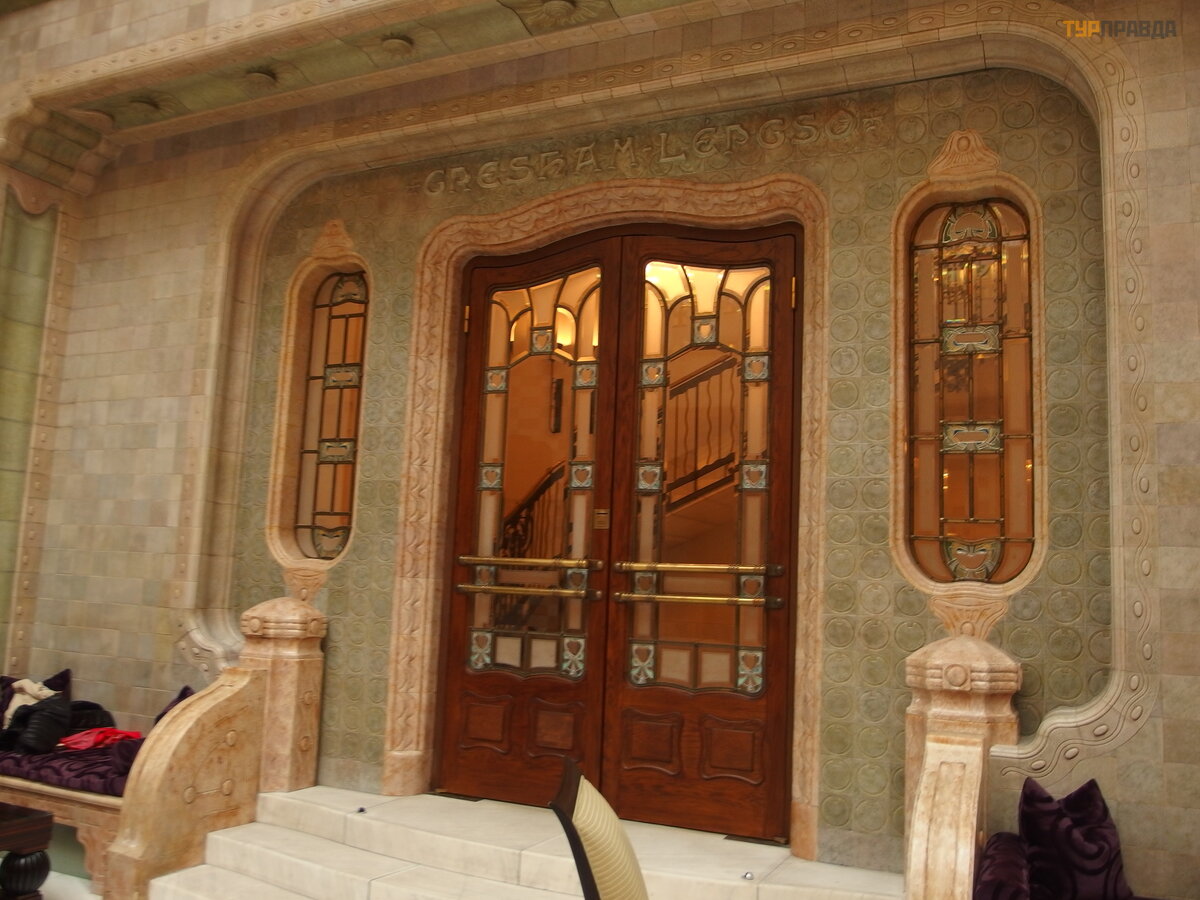
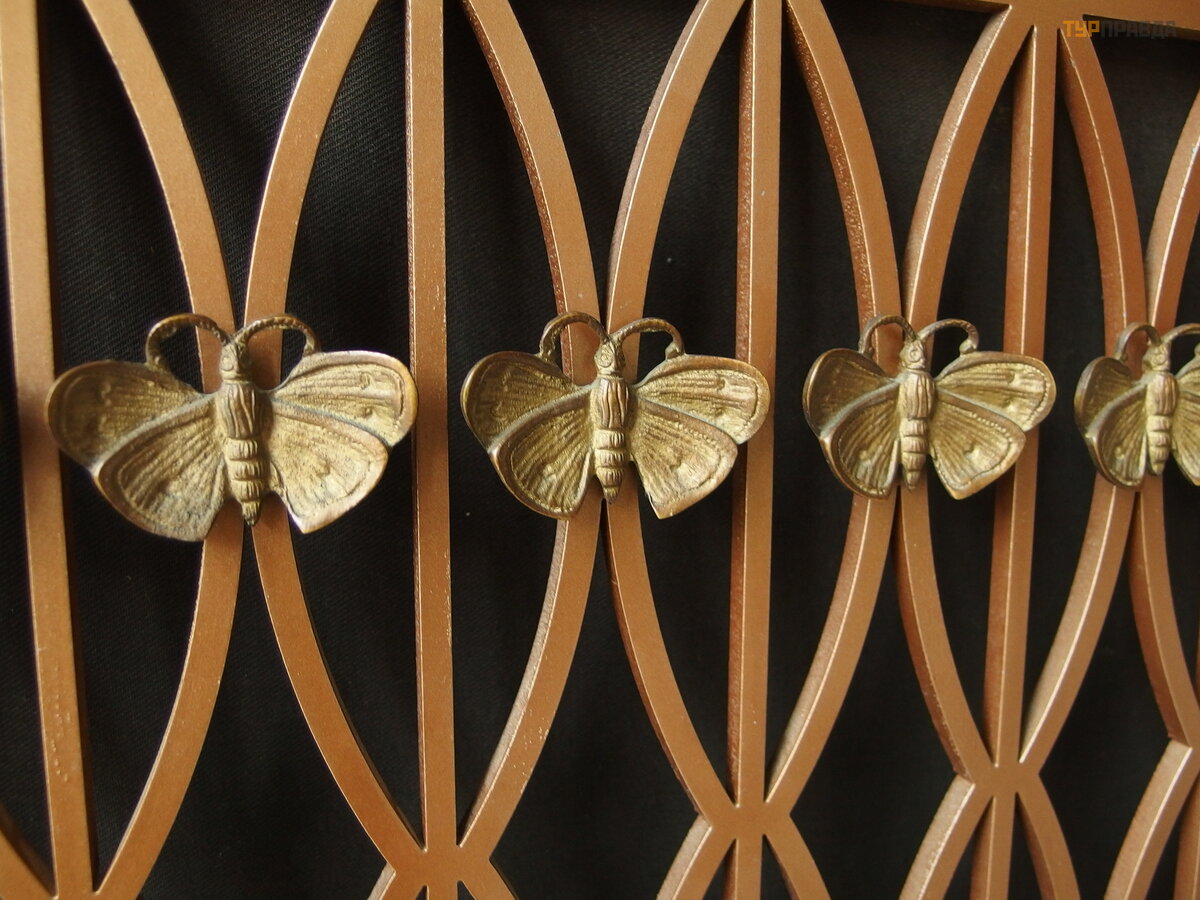
По пешеходной Zrinyi улице мимо многочисленных кафе и ресторанов, вот такого "обаяшки" жандарма:
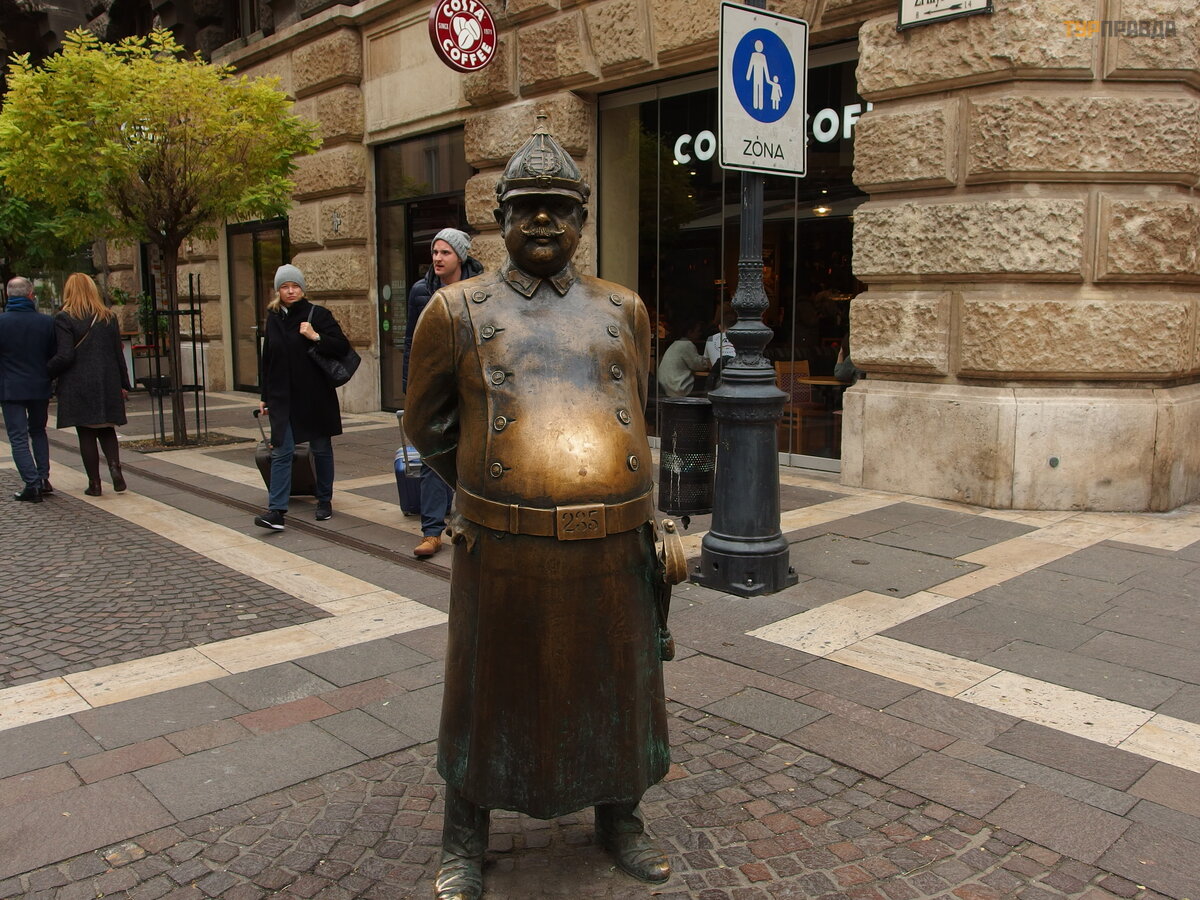
Выходим к базилике Святого Иштвана:
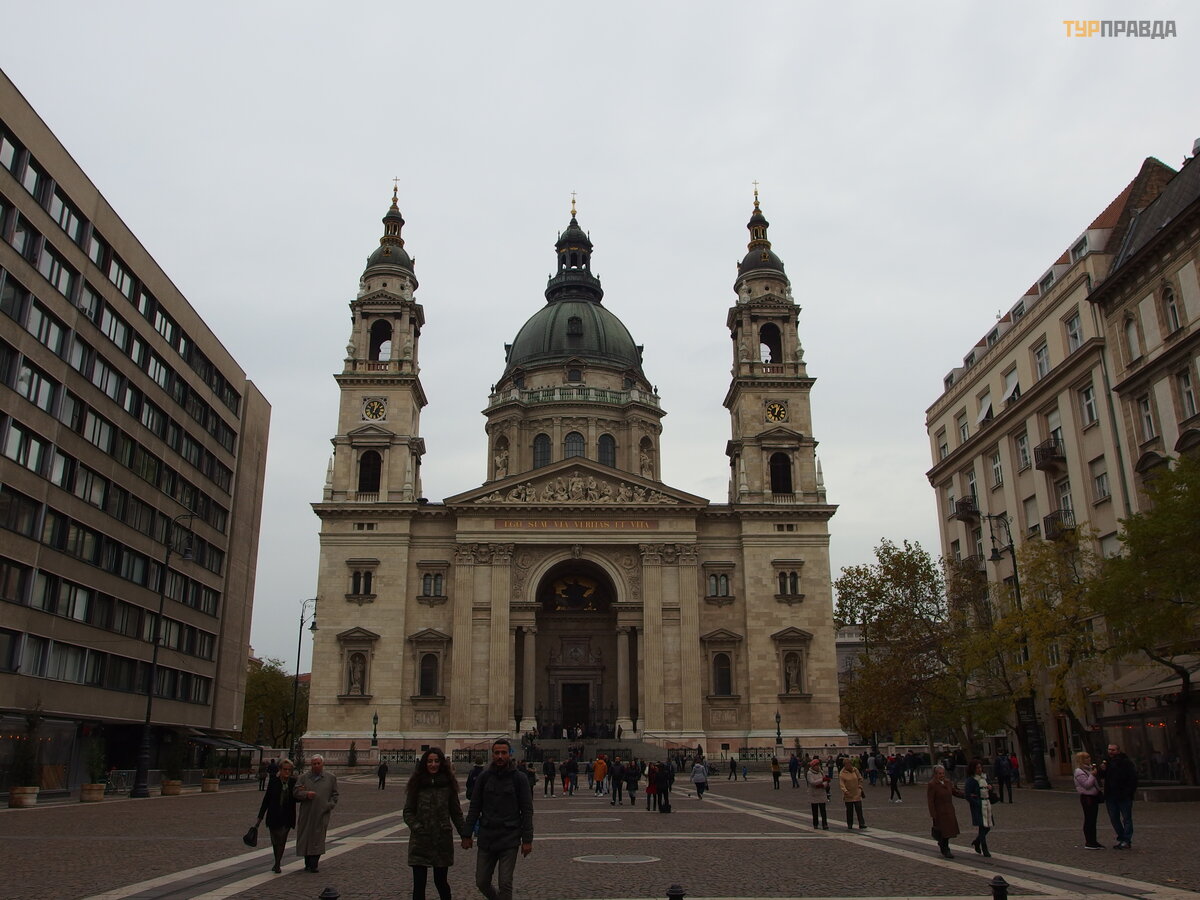
Святой Иштван Первый (Святой Стефан) – это самая значимая историческая и религиозная личность, главный мадьярский национальный герой. Ему посвящена самая крупная Базилика в Будапеште. День Святого Иштвана (20 августа – день его причисления к лику святых) – главный национальный праздник в Венгрии. Высота базилики такая же, как и высота купола здания Венгерского парламента – 96 метров. Собор представляет собой яркий пример неоклассицизма, популярного в середине XIX столетия. Начал строительство Йожеф Хильд, известный своим классическим, строгим и лаконичным стилем. После смерти Хильда обвалился купол собора, и строительство продолжил другой известный архитектор, Миклош Ибль. Продолжатель традиций неоклассицизма, при строительстве колоколен и купола он использовал некоторые элементы эклектики, чем придал храму легкий, но при этом величественный образ. Консультантом архитектора был знаменитый Эйфель. Собор был освящён 9 ноября 1905 года. Изнутри базилика Святого Иштвана выглядит "богато": великолепные росписи на стенах, много позолоты и резьбы, изящные статуи и огромный алтарь со статуей Иштвана Великого.
Направляемся на площадь Эржбеты. К фонтану Дунай и к "Глазу Будапешта":
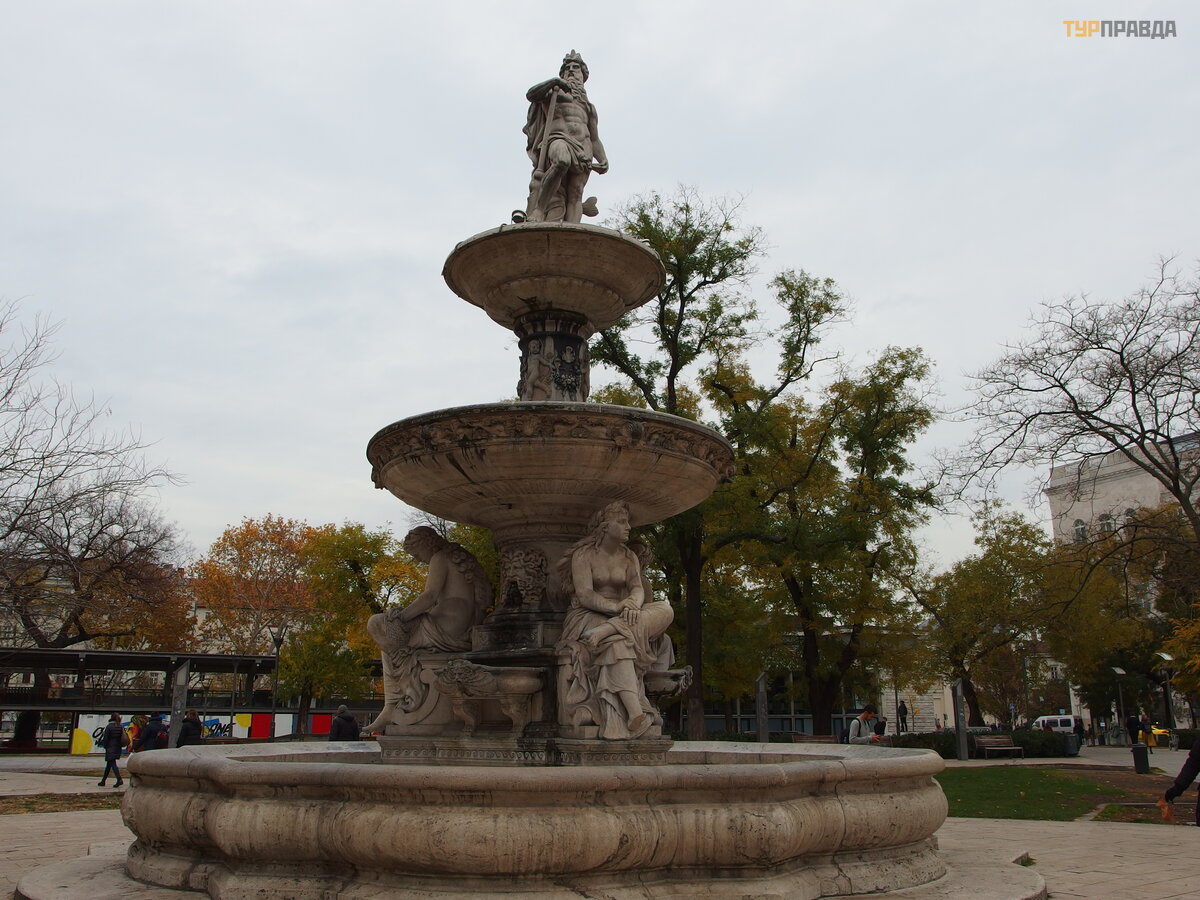 Женские фигуры, расположенные на нижней чаше, символизируют притоки Дуная: Тису, Драву и Саву. Во главе, скульптура, воплощающая сам Дунай
Женские фигуры, расположенные на нижней чаше, символизируют притоки Дуная: Тису, Драву и Саву. Во главе, скульптура, воплощающая сам Дунай
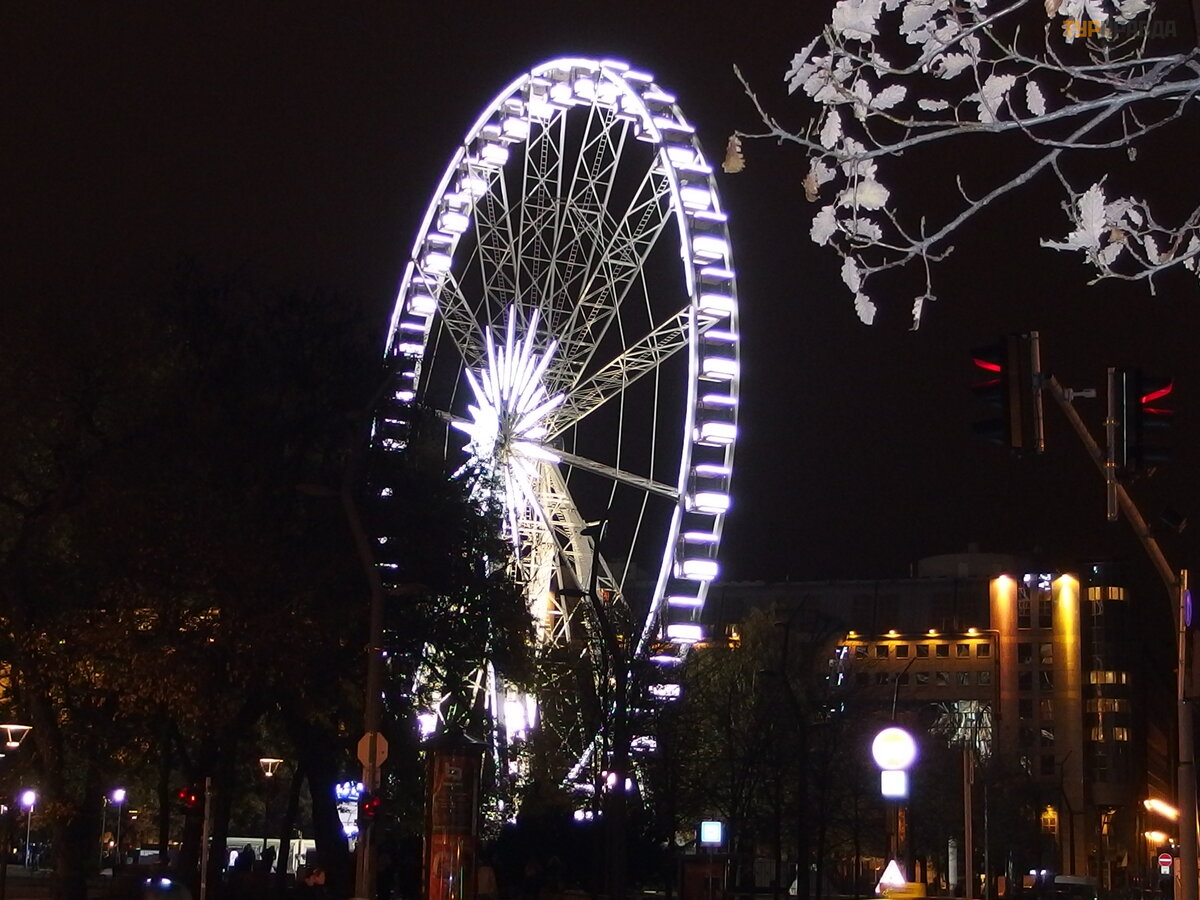 Глаз Будапешта
Глаз Будапешта
Еще взгляните на клуб "Аквариум", крышей которого выступает фонтан:
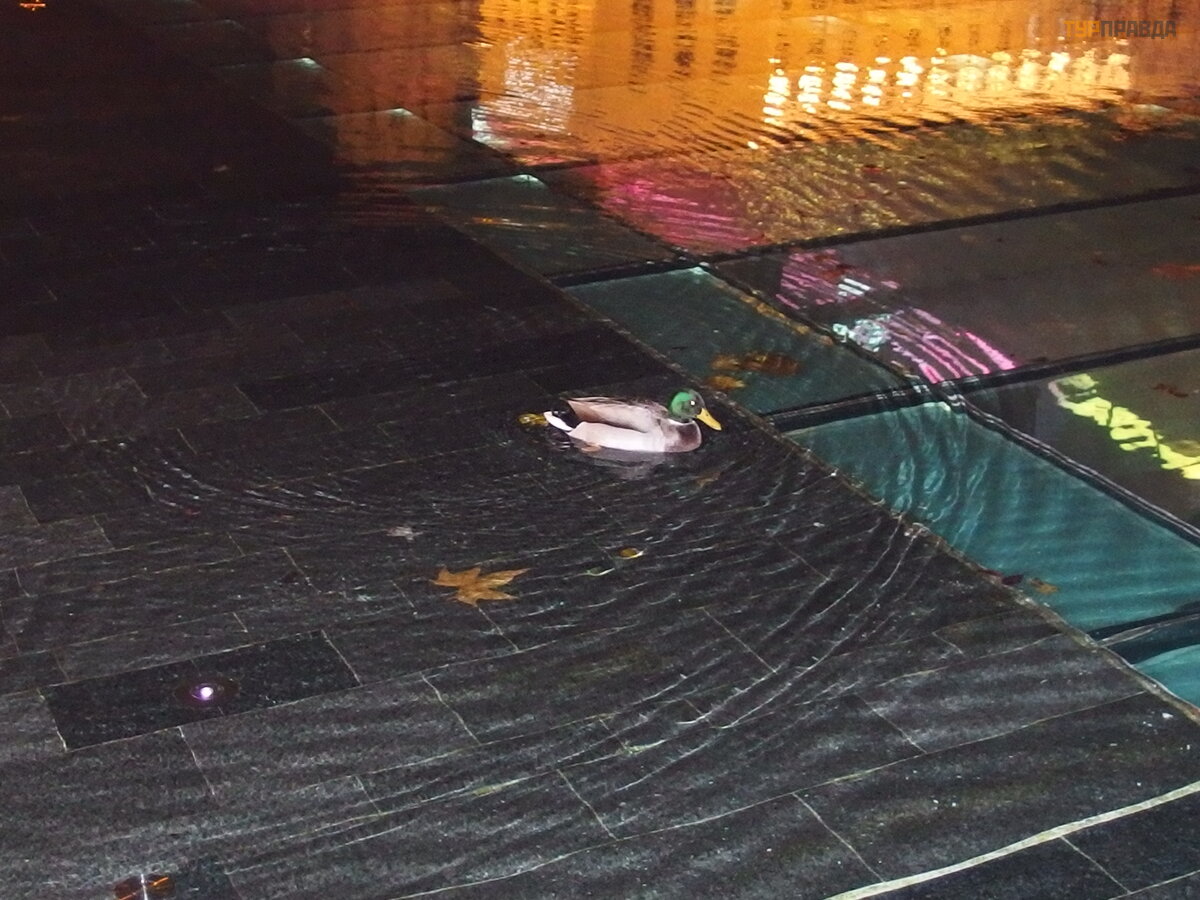 C уточками :)
C уточками :)
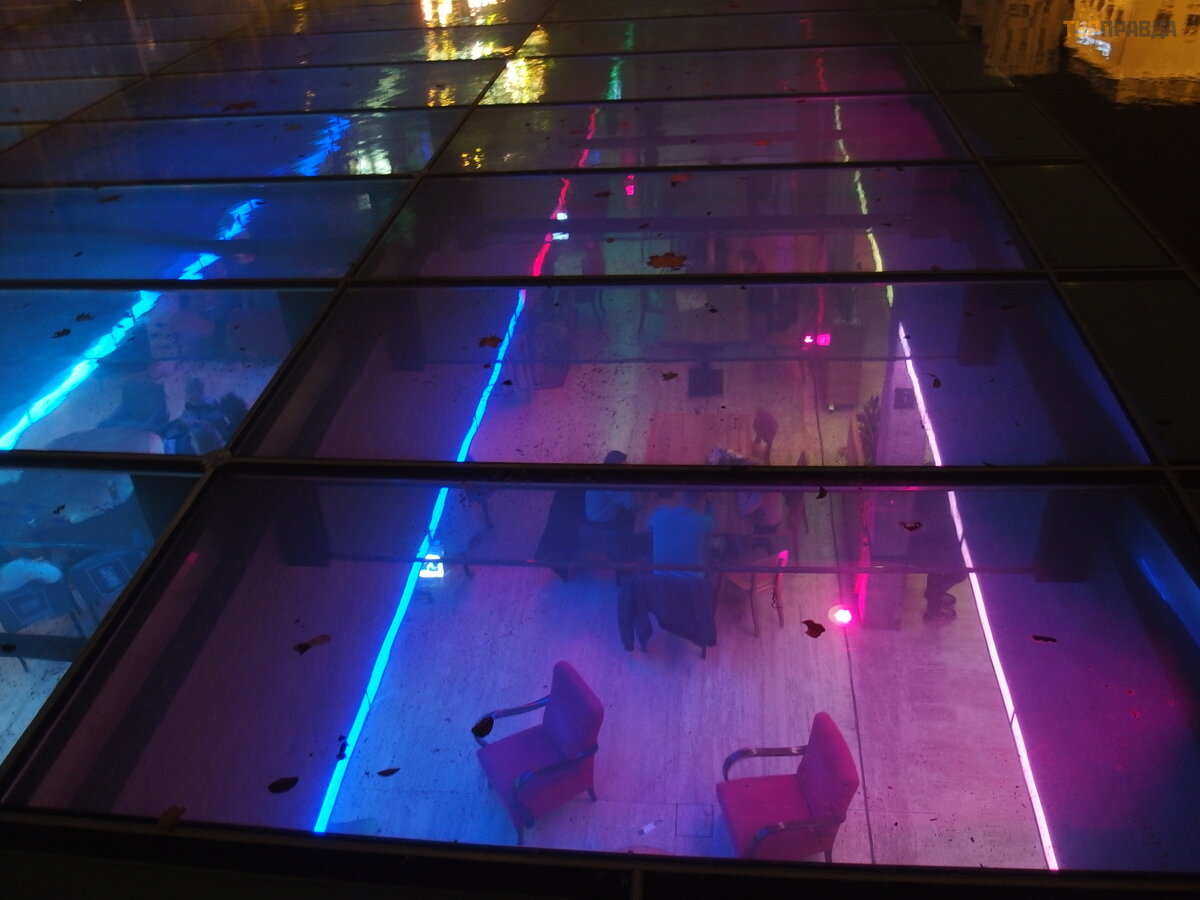
Обратите внимание на маленькую площадь Ференца Деака , названую в честь известного венгерского политика, занимавшего пост министра юстиции в независимом правительстве Венгрии в 1848-49 гг. При участии Деака был достигнут Австро-венгерский договор 1867 года, восстановивший конституцию Венгрии и равноправные отношения с Австрией (создана дуалистическая австро-венгерская монархия). Между прочим, королева Елизавета, или Сисси, которую так почитают в Венгрии, сыграла большую роль в заключении этого соглашения. Дело в том, что она много общалась с деятелями венгерской оппозиции (в частности, Ференцем Деаком и Дьюлой Андраши) и повлияла на позицию своего супруга по этому вопросу. В мае 1867 Елизавета и ее муж император Франц Иосиф были коронованы в Будапеште как король и королева Венгрии.
Обрамляет эту площадь Интересный жилой дом Anker-ház, построенный в 1907-1909 годах по проекту видного венгерского архитектора Игнаца Алпара (Alpár Ignác) (1855-1928), автора двух великолепных зданий на на площади Свободы (Фондовой биржи и Национального банка Венгрии), а также замка Вайдахуняд.
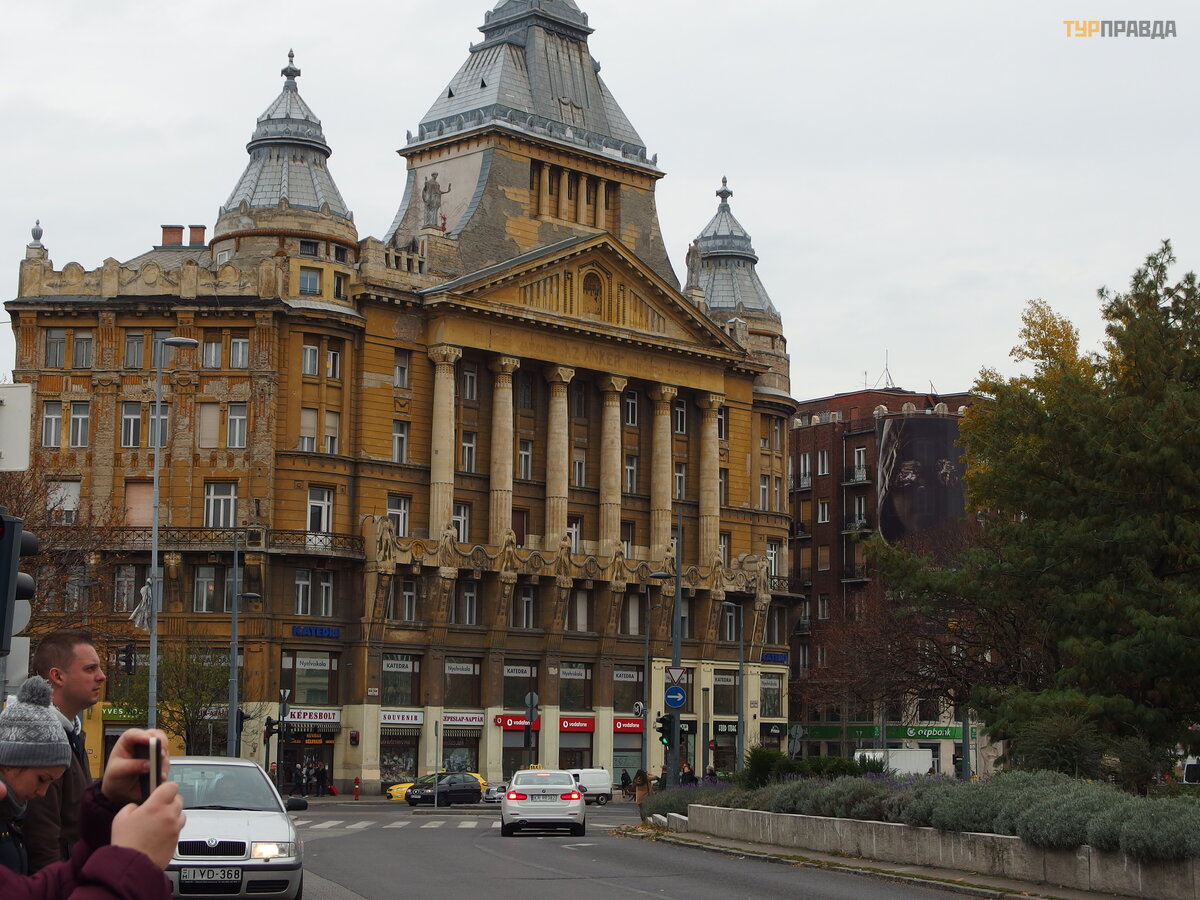
А теперь купаться :))) Купальни Лукач официальній сайт https://www.lukacsfurdo.hu/
Историческая справка: На будайском берегу Дуная, напротив острова Маргит, построена эта интересная будапештская купальня, имеющая богатейшие медицинские и культурно-исторические традиции. Когда-то территорию у подножия горы Иожеф, где расположены также купальни, как «Лукач» и «Часар», называли Фелхевиз, т.е. Верхние горячие воды. Само название уже указывает, что там на поверхность вырываются горячие источники. В районе нынешней купальни «Лукач» (Lukács fürd?) еще в XII в. целительской деятельностью занимались рыцари ордена госпитальеров Святого Иоанна Иерусалимского, известные впоследствии как мальтийские рыцари, построившие рядом с монастырями еще и купальни. В датированном XVI в. описании этих мест отмечается, что источники нынешней купальни «Лукач», уже тогда выбивавшиеся на поверхность, приводили в действие стоявшую здесь пороховую мельницу. После свержения турецкого ига купальня «Лукач» также перешла в собственность сокровищницы. По ходу времени ею владели разные арендаторы, в 1857 г. ее арендовал один мельник из Обуды, который и начал значительное расширение купальни.
В 1844 г. у купальни в лице Фюлёпа Палотаи появился новый хозяин. В 1884 г. началась ее масштабная реконструкция: построены SPA-отель, современный гидротерапевтический комплекс, перестроен бассейн. В появлявшейся информации о купальне отмечалось, что вода купальни «Лукач» по своему воздействию аналогична лечебным водам зарубежных термальных купален, например, Бадена в окрестностях Вены, Баден-Бадена и Пиештяны. Питьевой павильон сооружен в 1937 г. В 1979 г. здесь открылось первое в столице амбулаторное водолечебное отделение. Модернизация открытых бассейнов прошла в 1999 г., когда на месте не очень популярного «грязевого озерца» соорудили современный бассейн с сюрпризами (вихревой поток, подводные гейзеры, гидромассажные водопады, струйный массаж, подводные лежаки). Реконструкции подверглись и два разнотемпературных бассейна, которые оснастили мощной фильтровальной установкой. В купальне «Лукач» восемь бассейнов. Из них четыре лечебных бассейна (24-40 градуса Цельсия)
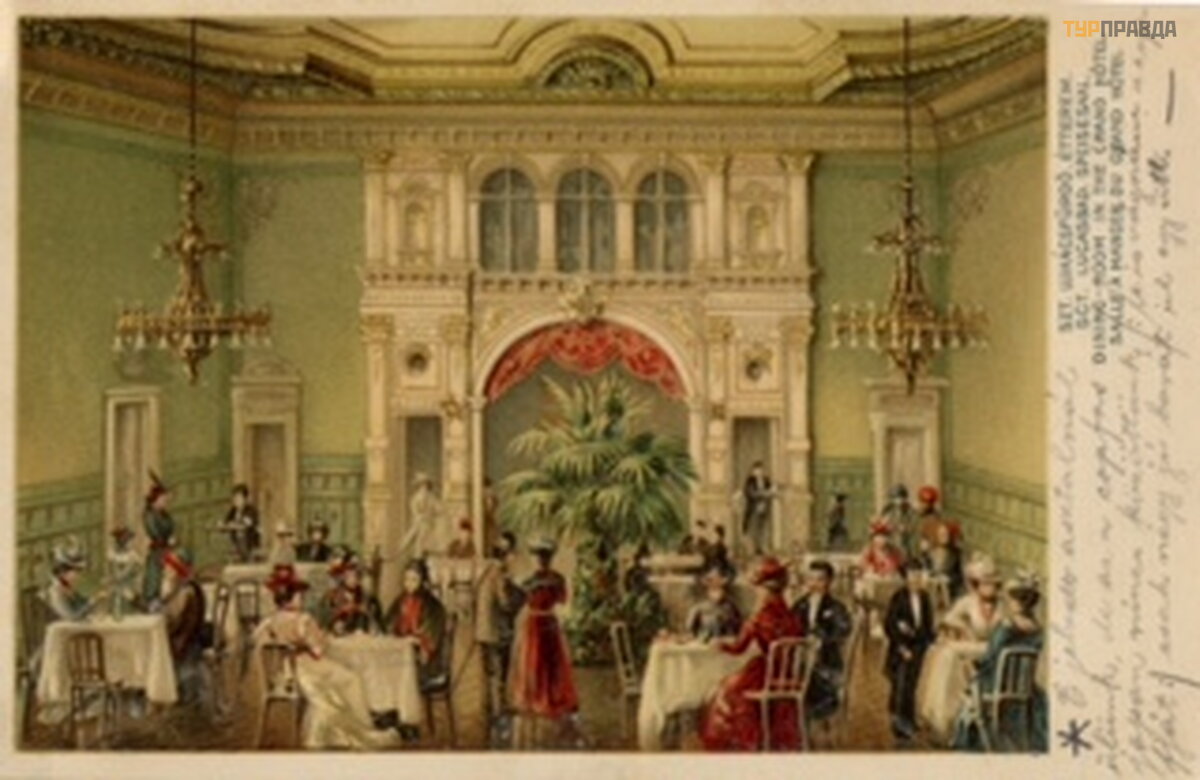
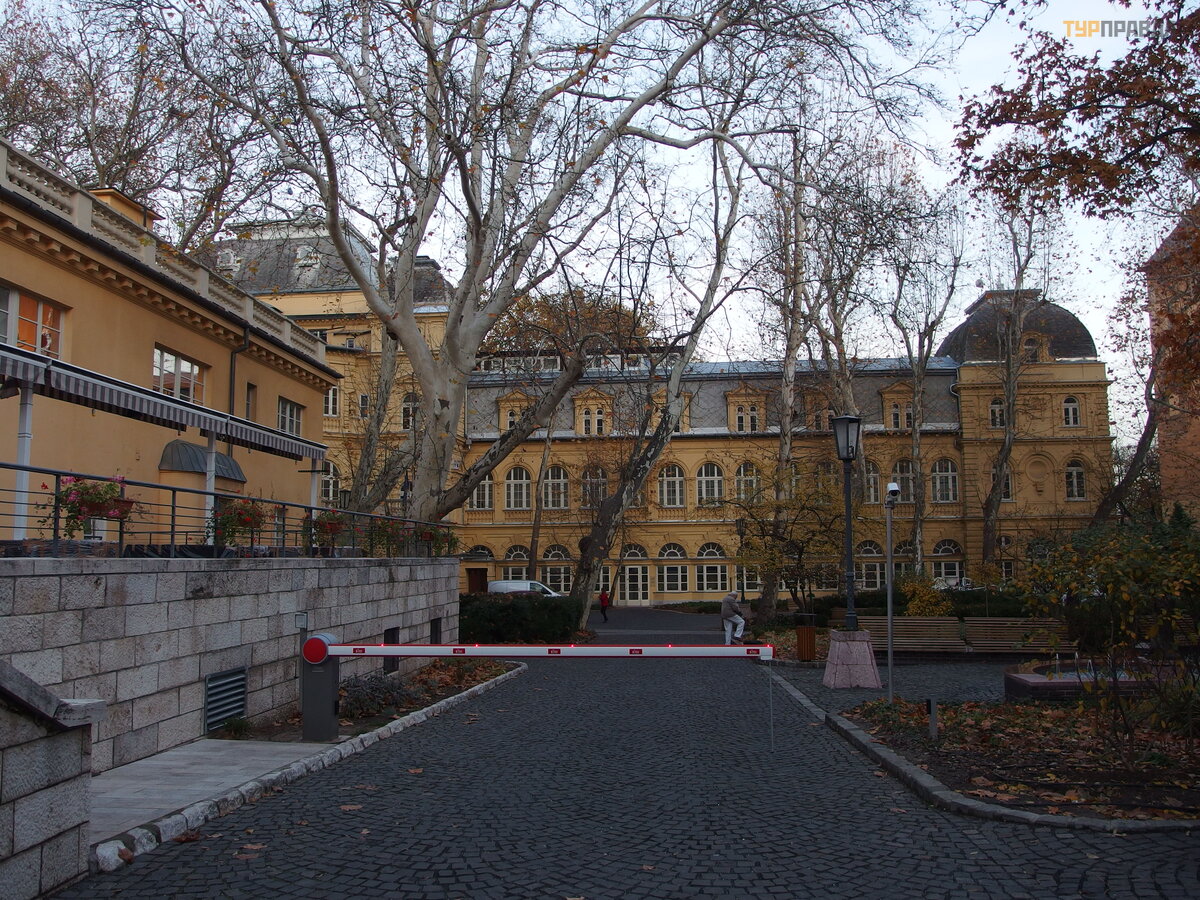
Продолжение здесь >>>

You ask why seven colors - seven days - seven walking routes - seven thermal baths.
I will not name, perhaps, such a second capital in Europe, where two different areas of recreation are so organically combined - sightseeing and resort. And if you decide to rest in late autumn, Budapest is what the doctor prescribed. If it suddenly rains or snows - hot thermal springs will always save you.
And although the trip was in doc-like times, monuments and places of interest remain the same. And even baths work with certain restrictions.
The international terminal is not very big and it is quite easy to figure out how to get to the bus stop. Stock up on a Pay Pass credit card to pay for bus tickets, and you won't need to change currency at the airport.
Tickets are sold in vending machines, multilingual menu (in Russian).
We took a bus to the metro to get to the center of Budapest. There is a large shopping center near the metro station. There is an exchanger (there is a commission) - if you need forints, but when trying to visit Hungary we try to change the currency in the banks (OTP Bank always has a good rate).
Since I planned to travel around the city a lot, I chose an apartment with a convenient location near the Nyugati train station.
Background: In 1846, the branch connecting Pest north of Vac became the first railway in Hungary. Over time, passenger traffic increased significantly, and the existing small station pavilion could not cope with it. It was decided to replace it with a more modern house. The French firm "Hey Fell", which became famous all over the world with the flag of that tower in Paris, proposed its project.
The new station was built in 1877 using progressive technology at the time - using a steel frame.

The trip plan was designed taking into account the location and optimal movement around the city (if you come for a week to buy a week late) Walks every day was planned to visit the various thermal baths in the area where the tour was planned.
Color red - romantic
On the day of arrival (2nd half for), which was a Friday, we drove to the Hotel Astoria and walked along Kossuth Lajos, to the Erzsebet bridge. Our goal for this night was the most luxurious Turkish bath Rudas (Rudas fü rd).
Historical background: Hotel "Astoria" was built in 1914. The events of the revolution of 1956 brought this house a sad popularity.
On October 25, protesters gathered here to prevent a column of tanks from advancing on the parliament building.
It all started quite peacefully, Protestants and Soviet soldiers talked to each other, people stuck flowers in the barrels of tanks. But a shot was fired and a Soviet officer was killed. In response, the army opened fire on protesters, resulting in casualties.
Walking along Kossuth Lajos, you should pay attention to the two most beautiful buildings in Budapest, the Clotilde Palace.
Princess Maria Adelaide Amalia Clotilda of Saxe-Coburg-Gotha and Kochari after her marriage became Archduchess of Austria, Princess of Hungary, the Czech Republic and Tuscany. In these palaces, by the way, never lived): Two residential palaces adorn the entrance to the bridge Erzsé bet. The houses look almost identical. They were built in 1902 for the daughter of Archduke Joseph - Clotilde. The building plan was created by Florish Korb and Kalman Girgel.
The palaces are decorated in neo-baroque style with Rococo elements.
First of all, all the rooms in the houses were residential, and today only on the top floor are prestigious apartments, and the lower levels are occupied by shops, cafes and a gallery of paintings.
Historical background: Erzsebet hid is named after the Empress of Austria-Hungary Elizabeth (Sissy), who died in 1898. It is the fourth permanent bridge across the Danube. In the year of its construction (1903) it was considered the longest suspension bridge, and this record he held until 1926. By the way, if you look closely, the famous Golden Gate Bridge in San Francisco is somewhat similar to him. During the war, the bridge was also blown up by the Germans. It is the only Budapest bridge that, for technical, economic and transport reasons, was not rebuilt according to the original design (1964 by Pala Shavoy).
And at the end of the evening a romantic walk on the bridge and no less romantic swimming.
Tenants carried out various reconstructions of the building, the condition of which was constantly deteriorating. The need for general reconstruction and modernization of the bathhouse became more and more urgent. On April 19.1866, the Buda City Assembly took over the management of the bathhouse. Under the control of the city authorities, separate parts of the bathhouse were gradually reconstructed. A department for a steam bath was separated from the common room, and in 1896 a swimming pool was opened. Since 1936, baths could be used only by men, and after the reconstruction, which was completed in 2005, women also had the opportunity to swim in the Rudash baths. On Tuesdays, only women can visit the baths, and Saturday and Sunday are public.
But Mondays, Wednesdays and Thursdays and Fridays still belong only to men: ))))
Official site https:// www. rudasfurdo. hu /
Orange - Parliamentary

Beautiful in any weather: )
The House of the Hungarian Parliament (1885-1904, Imre Steindl) is considered one of the hallmarks of Budapest. Prior to its construction, Hungarian lawmakers did not have a permanent seat. "Motherland does not have its own home" - so in the middle of the XIX century wrote the poet Mihai Vereshmarty. After the expulsion of the Turks in 1686, the Hungarian Legislative Assembly was moved to Poż on (now Bratislava in Slovakia). However, in the middle of the 19th century, with the growth of national self-consciousness, the question arose of the Hungarian parliament sitting in the capital.
Work began in 1885. The location for the future building was chosen on the banks of the Danube, where there used to be a city dump.
Given the difficult soil, we first had to strengthen it by pouring a massive concrete slab 2-5 m thick under the foundation.
The house is 268 m long and 123 m wide. The height of the main dome is 96 m (as in the Basilica of St. Stephen). You can get inside through 27 entrances. The parliament has 29 internal stairways, 691 rooms and 13 elevators. The facade is decorated with 90 statues and images of coats of arms of different cities and provinces, and inside - 152 statues! The house is lined with brittle sandstone, which is easily soiled (so you constantly have to clean the facades). The best Hungarian artists were involved in the design of the building, such as Miksha Roth, the stained glass artist, Mihai Munkaci, whose monumental painting "The Meaning of the Fatherland" adorns one of the halls.
Technical "stuffing" was also one of the most advanced at the time.
An indoor air conditioning system was installed indoors, which was cooled in special underground ice tanks in summer. The main entrance facing the square is "guarded" by lion figures.
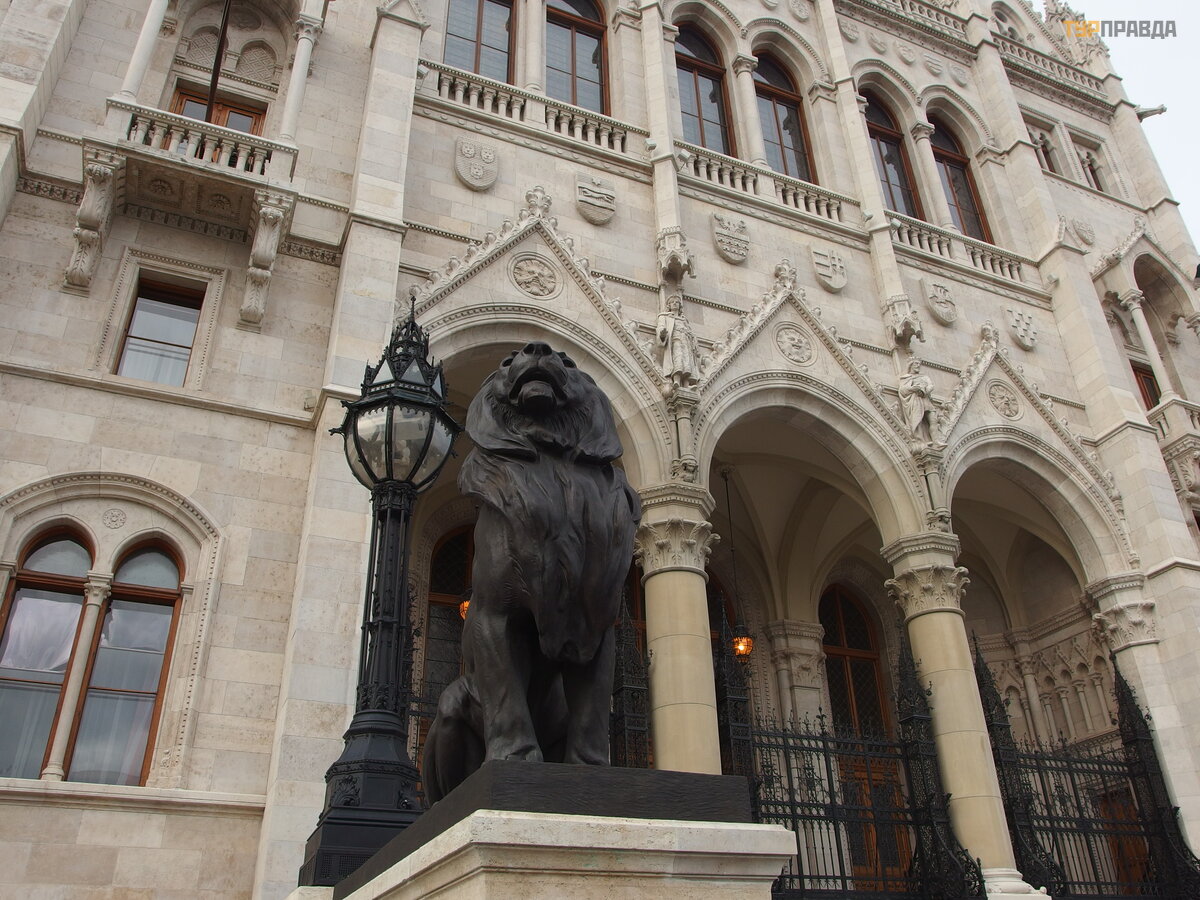
From it the main staircase goes upwards, the vault of the ceiling of which is decorated with a painting by Kara Lotz. These frescoes are called "Lawmaking" and "The Apotheosis of Hungary".

Stairs lead to the Dome Hall, which is 27 m high. Along the perimeter of the columns are 16 figures of famous rulers of Hungary: from the first king - St. Stephen I and ending with Emperor Leopold II of the Habsburg dynasty.
In the center of the hall under the glass are on display the Hungarian crown and the attributes of royal power: the state, scepter and coronation sword.
Two wings depart from the Dome Hall, which housed the meeting rooms of the upper and lower chambers. In present-day Hungary, the Legislative Assembly consists of only one chamber, with 386 legislators. The meeting room is located in the south wing.
It is separated from the Dome Hall by a grand foyer. Along the walls of the foyer there are five niches, separated from each other by columns with figures depicting representatives of different professions. The architect is depicted in a sculpture by the author of the project of the building itself - Imre Steindl. The ceiling is decorated with frescoes by Sigismund Weid, illustrating the ancient history of the Hungarians. The meeting room resembles a horseshoe in shape.
On the wall behind the presidium are two canvases depicting important moments in the history of the Hungarian state: the opening of the Assembly of People's Representatives in 1848 and the coronation of Emperor Franz Joseph in 1867. Between them is the national coat of arms of Hungary, surrounded by the coats of arms of all the dynasties that ruled the kingdom - the Arpads, the Anjou dynasty, the Hunyadi family, the Polish house Jagiello, Zapilla and the Habsburg-Lorraine house. Behind the meeting room are the offices of the Prime Minister and the President.
The hall in the north wing of the building, where the upper house of parliament used to sit, is used for various international events, conferences and congresses. The proclamation of the Golden Bull in 1222 by King Andrew II and the oath of allegiance of the Hungarian Parliament to the Empress Maria Theresa of Austria in 1741 are dedicated to the poem.
The Congress Hall is separated from the Dome Hall by a richly decorated foyer decorated with 32 allegorical figures symbolizing professions related to agriculture, animal husbandry, industry, trade, various sciences and arts.
The frescoes on the ceiling of Sigismund Weida's work represent scenes from history: "Saint Laszlo gives people medicinal herbs for plague", "King Kalman the Scribe forbids the burning of witches", "Ab Bat Astrik hands over the crown to King Stephen I", " Allegory of the Glory of the Cross ", " King Matthias among the people ", " King Lajos I the Great commissioned the construction of a cathedral in the city of Kasha ".
The parliament building was badly damaged during World War II: in 1944-1945, about 250 air bombs hit it. However, the house was completely restored. In Soviet times, the spire of the main dome was decorated with a pentagonal star, similar to the stars of the Moscow Kremlin.
The square in front of the parliament building is often used on public holidays. Military parades are held here, accompanied by a ceremony of raising the state flag. In the square, Hungarians express their dissatisfaction with the government's policy.
Monuments to outstanding freedom fighters have been erected here.

In the southern part of the square is the equestrian monument to Ferenc Rakoczi (1676-1735) (1936, Janos Pastor), who was the leader of the anti-Habsburg national liberation war of the early 18th century. On one side of the pedestal is carved the motto of the rebel peasants: "For homeland and freedom. " On the other are Racco's words: "The original wounds of the Hungarian people are being rekindled. "
Lajos Kossuth (1802-1894), a participant in the 1848 revolution and liberation war, looks at the hero of the peasant war from the opposite side. A monument to him was erected in 1927.
However, he was disliked by Hungary's post-war communist dictator, Matthias Rakoshi, who considered him "depressed". As a result, the monument was dismantled, but in its place in 1952 a more "life-affirming" monument was erected, reminiscent of typical Soviet monuments to revolutionary heroes.
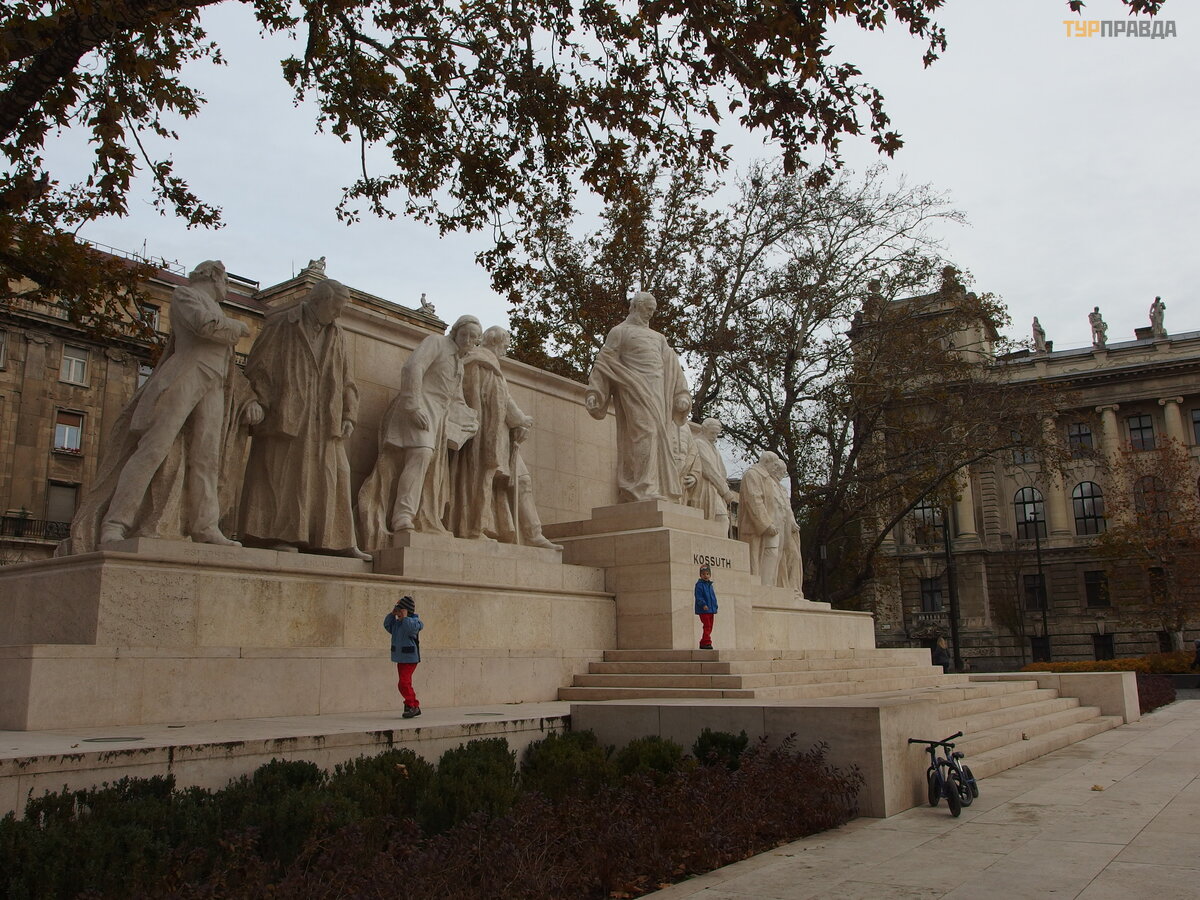
After entering the museum of the parliament, you will see the monument to Istvan Tisza (gró f Tisza Istvá n). Istvan Tysa (1861-1918) - Hungarian politician, Prime Minister of the Kingdom of Hungary. Gained popularity by reburial of the remains of Ferenc II Rakoczi. Reading his biography, you wonder: "And what more did he do to the Hungarians harm or benefit? " Contemporaries fiercely hated him. He had three unsuccessful attempts, and the fourth succeeded. And the descendants erected a monument.
The monument to Count Tisza by sculptors Derd Hall and Antal Orban was unveiled on April 22.1934.
(April 22 - Tisa's birthday). In the spring of 1945 the monument was destroyed. Until recently, there was a monument to Mihai Karoya, the "left" prime minister and president of Hungary, who came to power as a result of the same revolution that killed Count Tisza. And under which Hungary lost almost everything it could have lost, more precisely under the Versailles Peace Treaty of 1918
The monument to Kara was removed. In its place was restored a copy of the old monument to Count Tisza (sculptor Istvan Elek).

At the monument to Ferenc Rakoczi, descending to the square, you can see the memorial to the victims of the Hungarian uprising of 1956
And after passing closer to the embankment, two more monuments: Count Gyule Andrá s schykentkiraia and Krasnogorka (Gyula Andrá s ssy Gyula, Hungarian. Andrá ssy Gyula; March 3.1823, Olakhpatak, Austrian Empire - February 18.1890, Wallachia, Wallachia, Wallachia Wallachia Austria-Hungary) - Hungarian statesman and politician.
An active participant in the Hungarian Revolution of Independence in 1848-1849.

And the Hungarian poet Jozef Attila.
The poet is depicted sitting on the steps of the embankment with a hat in his hand, the monument is engraved with lines of his poems about the Danube. Attila Jozef was only 32 years old when he committed suicide by throwing himself under a train.
This is a true classic of Hungarian poetry. It is no coincidence that the Day of Poetry in Hungary is celebrated on April 11, the birthday of Attila Jozef.
There was a whole story with this monument. During the reconstruction of the square, it was going to be removed, but in November 2011 the townspeople staged the "Jozef Attila Marathon" - all Saturday and all night on Sunday, 32 hours in a row, according to the number of years he lived, one after another read his poems in the square.
 А? body Yo? Jó zsef Attila (Hungarian: Jó zsef Attila; 11 April 1905 (1905-04-11), Budapest - 3 December 1937, Balatonsarso)
А? body Yo? Jó zsef Attila (Hungarian: Jó zsef Attila; 11 April 1905 (1905-04-11), Budapest - 3 December 1937, Balatonsarso)
60 pairs of metal shoes and shoes can be seen on the paved sidewalk on the Danube embankment in front of the parliament building. This is a Holocaust Remembrance Memorial (2005 , by Gyula Power and Ken Togei) commemorating the Jews shot by the Hungarian Nazis in 1944-1945.

From the end of the building of the Ministry of Agriculture you can see Vertanuk Square ( Vertanuk tere , > Martyrs), in the center of which, in a small square is an unusual sculptural composition. On the bridge over the artificial stream stands a bronze figure of a man in a hat, his sad gaze turned to the majestic parliament building. It is a monument to Imre Nadia (1896-1958) (1996 Tamas Varga), a Hungarian statesman who served as Prime Minister during the tragic events in Hungary in the autumn of 1956. He supported and led the 1956 uprising
Ask yourself if there is a person in our government now who will give his life for the idea of freedom and independence of his country without hesitation. Nadia was accused of "treason" and hanged. He had the opportunity to ask for pardon, but he refused, saying that history and the world communist movement would decide who was right.

Continuing our walk through Lipotvaros (this is the area of Budapest) along Vecsey Street, we reach Freedom Square.
Under the ground (almost below this street) between Freedom Square and the neighboring Kossuth Square is the former bunker of the Hungarian communist dictator Matthias Rakoshi, who called himself "Stalin's best faithful disciple. " Construction began in 1949 and ended in 1953.
The 2.200-strong bunker was intended to shelter the top leadership of the Hungarian Workers' Party in the event of a nuclear strike. It was connected to a nearby parliament building and had exits to a metro line that could be used to evacuate the country's leadership to another safe place. After the end of the Cold War, the bunker was abandoned. Today it belongs to the state and belongs to the strategic objects without danger.

Very monumentally, a monument to Ronald Reagan, a politician and president of the United States, has been erected in Freedom Square, a few meters from the memorial to Soviet soldiers killed in World War II. It was opened in 2011. Reagan played a huge role in ending the Cold War, as a result of which Hungary gained independence.
Hundreds of locals attended the unveiling ceremony.

Historical Hope:
This was the site of the Neugebode barracks complex, which housed the arrows of the Austrian garrison. During the War of Independence of 1848-1849, the building was used as a prison, where many members of the national liberation movement were imprisoned, some of whom were executed in the courtyard. Among them was the first Prime Minister of Hungary, Lajos Battiani.
Since then, the building has become a figurative "Bastille" for Hungarians, and its memory is still associated with force and cruelty aimed at suppressing the desire for independence.
In 1897, the hated building was demolished, and in its place decided to make Freedom Square. It was built with luxurious palaces designed by the best architects.
On the lower side, the square frames the former stock exchange building (1897-1907, Ignac Alpar), which at the turn of the century was considered the largest such structure in Europe.
The monumental electric building, originally built for the Budapest Stock Exchange, was designed and erected by architect Ignac Alpar (1897-1907). It was the largest palace of its kind in Europe, symbolizing money, wealth and power.
The first stock exchange in Budapest was founded in 1854 in the Lloyd's Palace, located at the southern end of Roosevelt Square.
In 1893, the stock exchange moved to a building on Freedom Square. Construction of the new Stock Exchange building began in 1902 and was completed in 1907. On May 25.1948, the exchange closed. Later, the Lenin Institute and the House of Technology were established here, where the headquarters of scientific associations were located.
Hungarian television moved here in 1955, and in the 1960s received it at its full disposal. A few decades after numerous redevelopments, the palace has changed a lot, its original original interior can now be seen only in archival photographs.
On the east side of the square is the facade of the National Bank of Hungary (1902-1905, Ignac Alpar), followed by the US Embassy.
And on the east side of the American embassy you can find one of the most picturesque buildings in Pest - the Post Office Savings Bank of the Savings Post Bank (Postatakaré k-pé nztá r).
The building was built in 1899-1902 by the famous architect Eden Lechner and is considered the ancestor of a new style that combines the standards of modernism with elements of national motifs.
And the roof, decorated with flowers, angel wings, dragon tails and other exotic motifs, has no analogues at all - when the masters asked why such a rich decoration in an element completely invisible from the street, he replied: "Why don't birds admire them? ".
After the First World War, which ended in a national tragedy for Hungary (the country lost two-thirds of its territory and one-third of its population), monuments to the lost lands appeared in the northern part of the square. On May 1.1946, a monument to Soviet liberators (strong> ) (1946, Antal Karoy) who died during the liberation of Budapest was erected in their place.
Today it is the only monument left in the city to the Red Army soldiers. Others after the revolution in 1989 were either transferred to the city cemeteries, where the dead Soviet soldiers are buried, or were placed in the sculpture park of the Soviet period.
Some local organizations are collecting signatures for the demolition of this monument and the return of the original monument.
A little further away, in the shade of trees in front of the US Embassy, you can see a modest-sized bronze monument to US General Harry Hill Bandholtz (1864-1925) (1936, Miklos Ligeti), who immediately became a national hero. In October 1919, he headed the Allied mission to disarm Hungary and control the withdrawal of Romanian troops. In the evening of October 5, the Romanian military, which occupied Budapest, tried to take out the treasures of the National Museum.
Upon learning of this, General Bandholtz immediately went to the museum and saved his collection from looting (according to legend, he stopped the Romanian soldiers, armed only with a whip).
In addition, he saved the furniture of the royal palace and prevented the Romanian authorities from arresting the Prime Minister of Hungary, Istvan Friedrich. In his homeland, Bandholtz is considered the "father" of military police in the US Army.

And the monument to the victims of the German occupation completes the square:

From Freedom Square we return to the Danube and head to the Chain Bridge.
In total, there are 9 bridges in Budapest, 2 of which are railway: Chain (Lion) Bridge, Erzebet Bridge, Freedom Bridge, Margit Bridge, Sá ndor Pető fi Bridge, Lanczhid Bridge, Arpad Bridge.
Chain Bridge (Lion), or Secheni Bridge - the most "central" bridge, because it leads from Parliament to the Buda Castle. He is also called the "Old Lady". It is the first permanent bridge on the Danube, which is also one of the symbols of Budapest.
During World War II, the bridge was blown up by the Germans, and after its restoration, it was reopened on November 20.1949, day after day, a hundred years after its first surrender. From the bridge begins a tunnel under the fortress mountain, which is 350 meters long - equal to the length of the bridge. There is even such a touching joke: the bridge is taken to the tunnel in the rain. ; )
The initiator of the construction of the bridge was Count Istvan Szechenyi, who had to wait a whole week until a brave boatman dared to take the count from Pest to Buda, maneuvering between huge ice floes.
And then the count said he was willing to give his annual income to build a permanent stone bridge across the Danube, and, of course, the bridge was built (designed by William Tierney Clark and his namesake builder Adam Clark in 1839-1849), and a little later - And the tunnel. The chain bridge is officially named after Count Secheny.
An integral part of the bridge are the majestic figures of lions (sculptor J. Marshalko). At first, the townspeople did not accept them, reproaching the sculptor for the lack of languages in the lion's mouth. In response, Marshalko published an article: "Lions are not dogs, and their tongues do not hang down. " The bridge and the panorama of the city, which opens from it, look especially impressive in the evening, when the lights are turned on.

We go to a small square in front of the bridge and approach the Gresham Palace:

One of the greatest examples of Hungarian Art Nouveau is Gresham Palace. The area occupied by the palace is 12 thousand square meters. It was once one of the largest residential buildings. The style in which it is built is called - Art Nouveau (Secession) of the Art Nouveau period. Now the palace houses the hotel "4 seasons".
According to historical records, the palace was usually a large private house, then called - Nakó Palace (Nakó -palota). In 1880, the London Insurance Company, headed by Thomas Gresham, acquired the building. It was supposed to house the company's office, but in 1904 Nako's palace was demolished. In 1905, a competition was announced for the best design of a new building. The work of the Hungarian architect Sigismund Kvittner was chosen from numerous applications, and in 1907 a new palace was built on the waterfront, which impresses with its size and decoration.
The building was decorated with allegorical figures, mosaic panels, wrought iron trim and floral ornaments. All this was to emphasize the well-being of the British Empire, Gresham's homeland.
This is one of the most beautiful places in the city. No wonder the location of the palace was chosen.
Gresham Palace in Hungary was considered the most fashionable place. The building has three main stairs, which were named after Count Jules Andrá ssy, Thomas Gresham and Lajos Kossuth. Huge stained glass windows glowed brightly in the stairwells, with portraits of these famous people in the center. By the way, these stained glass windows are the work of the genius Mixi Roth.
The global crisis has affected many companies, including Gresham. In 1939 the representative office had to be closed. The palace was badly damaged during World War II. The shells damaged the roof of the passage and stained glass windows.
After the war ended in 1948, the Hungarian government privatized the house. For a long time no one was engaged in restoration.
For a long time there was a library in the building, then representations of different states, and in the 70's the building was given to communal apartments.
After the fall of the communist regime, the palace building was privatized again. Restoration works have been carried out for many years. Finally, in 2004, Gresham Palace opened, but as a hotel "Four Seasons Gresham Palace". In 2011 it was bought by the Sultanate of Oman. In 2005, another global restoration was completed, during which the almost original appearance of the palace was restored.



On the pedestrian street Zrinyi past numerous cafes and restaurants, here is such a "charm" of the gendarme:

We go to the Basilica of St. Stephen:

Saint Stephen I (Saint Stephen) is the most important historical and religious figure, the main Hungarian national hero. The largest basilica in Budapest is dedicated to him. St. Stephen's Day (August 20 is the day of his canonization) is the main national holiday in Hungary. The height of the basilica is the same as the height of the dome of the Hungarian Parliament building - 96 meters. The cathedral is a striking example of neoclassicism, popular in the mid-nineteenth century. Jozef Hild, known for his classic, austere and concise style, began construction. After Hilda's death, the dome of the cathedral collapsed and was continued by another famous architect, Mikló s Ibl. Continuing the tradition of neoclassicism, in the construction of bells and baths, he used some elements of eclecticism, which gave the church a light but majestic image. The famous Eiffel was the architect's consultant.
The cathedral was consecrated on November 9.1905.
Inside the Basilica of St. Stephen looks "a lot": beautiful paintings on the walls, a lot of gilding and carvings, elegant statues and a huge altar with a statue of Stephen the Great.
Head to Erzbeta Square. To the Danube Fountain and to the "Eye of Budapest":
 Female figures located on the lower bowl, symbolize the tributaries of the Danube: the Tisza, Drava and Sava. At the head is a sculpture embodying the Danube itself
Female figures located on the lower bowl, symbolize the tributaries of the Danube: the Tisza, Drava and Sava. At the head is a sculpture embodying the Danube itself
 Око Будапешта
Око Будапешта
Take another look at the Aquarium Club, which has a fountain on its roof:
 C уточками: )
C уточками: )

Note the small square of Ferenc Deak, named after a famous Hungarian politician who served as Minister of Justice in the Independent Government of Hungary in 1848-49.
With the participation of Deak, the Austro-Hungarian Treaty of 1867 was reached, which restored the Hungarian constitution and equal relations with Austria (a dualist Austro-Hungarian monarchy was established). By the way, Queen Elizabeth, or Sissy, who is so revered in Hungary, played a major role in concluding this agreement. The fact is that she talked a lot with the Hungarian opposition (in particular, Ferenc Deak and Gyula Andrá ssy) and influenced her husband's position on this issue. In May 1867, Elizabeth and her husband, Emperor Franz Joseph, were crowned King and Queen of Hungary in Budapest.
This square is framed by the interesting Anker-há z residential building, built in 1907-1909 by the famous Hungarian architect Alpá r Igná c (1855-1928), the author of two magnificent buildings on Freedom Square (Fond and National Bank of Hungary), as well as Vaidahunyad Castle.

And now swim: ))) Bathing Lukac official site https:// www. lukacsfurdo. hu /
Historical background: This interesting Budapest bathhouse, which has the richest medical and cultural-historical traditions, was built on the Buda bank of the Danube, opposite the island of Margaret. Once the area at the foot of Mount Jozef, where there are also baths such as "Lukac" and "Clock", was called Felheviz, ie the Upper Hot Waters. The name itself indicates that hot springs are breaking out on the surface. In the area of the present bath "Luká cs fü rd? " In the XII century. The Knights of the Order of Hospitallers of St. John of Jerusalem, later known as the Knights of Malta, practiced healing, and built baths next to the monasteries. In the dated XVI century.
In the description of these places it is noted that the sources of the present bath "Lukach", which were already coming to the surface at that time, powered the powder mill that stood here.
After the fall of the Turkish yoke, the Lukac baths also became the property of the treasury. Over time, it was owned by various tenants, in 1857 it was rented by a miller from Obuda, who began a significant expansion of the bath.
In 1844 a new owner appeared in the bathhouse in the person of Fyulop Palotai. In 1884, its large-scale reconstruction began: a SPA-hotel, a modern hydrotherapy complex, a swimming pool were rebuilt. In the information about the emerging bath, it was noted that the water of the bath "Lukacs" in its influence is similar to the healing waters of foreign thermal baths, such as Baden on the outskirts of Vienna, Baden-Baden and Piestany. The drinking pavilion was built in 1937. In 1979.
the first outpatient hydrotherapy department in the capital was opened here. Modernization of outdoor pools took place in 1999.
, when a modern swimming pool with surprises was built on the site of the not very popular "mud lake" (vortex flow, underwater geysers, hydromassage waterfalls, jet massage, underwater sunbeds). Two pools of different temperatures, which were equipped with a powerful filtering unit, also underwent reconstruction. There are eight swimming pools in the Lukach swimming pool. Of these, four treatment pools (24-40 degrees Celsius)


Continued here>>> < / em>
 А? body Yo? Jó zsef Attila (Hungarian: Jó zsef Attila; 11 April 1905 (1905-04-11), Budapest - 3 December 1937, Balatonsarso)
А? body Yo? Jó zsef Attila (Hungarian: Jó zsef Attila; 11 April 1905 (1905-04-11), Budapest - 3 December 1937, Balatonsarso)  Female figures located on the lower bowl, symbolize the tributaries of the Danube: the Tisza, Drava and Sava. At the head is a sculpture embodying the Danube itself
Female figures located on the lower bowl, symbolize the tributaries of the Danube: the Tisza, Drava and Sava. At the head is a sculpture embodying the Danube itself 
























































































